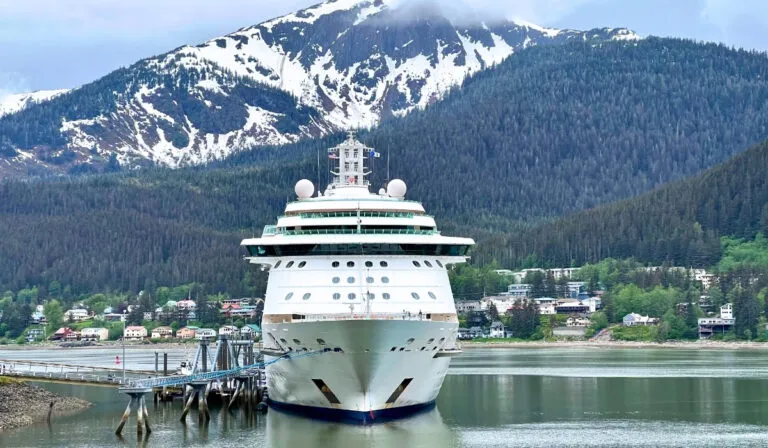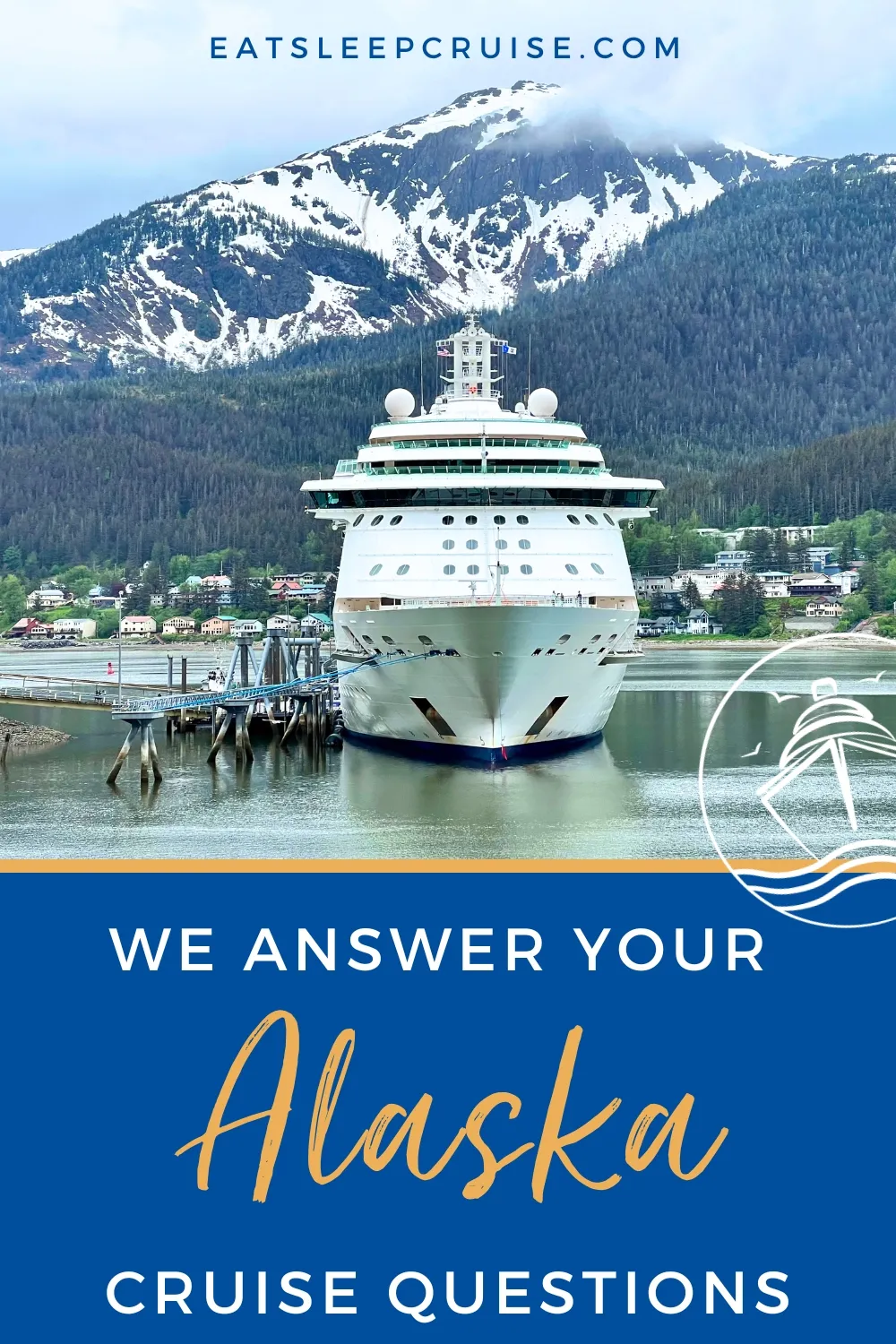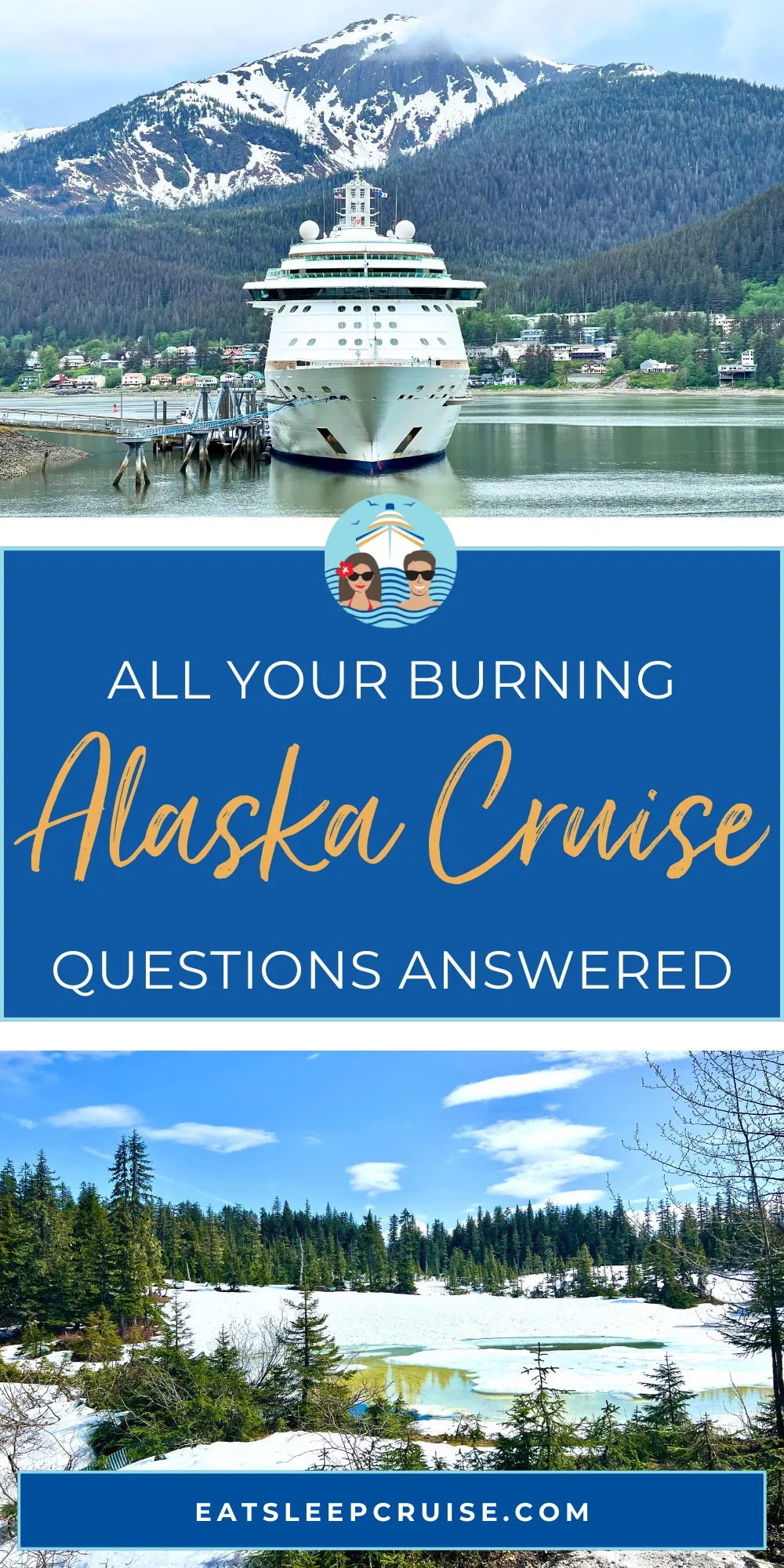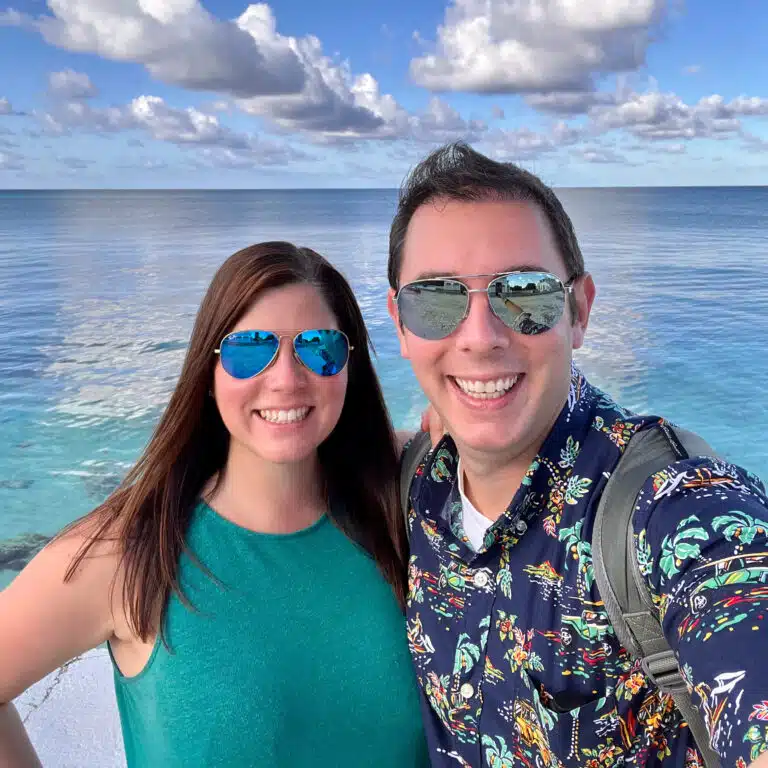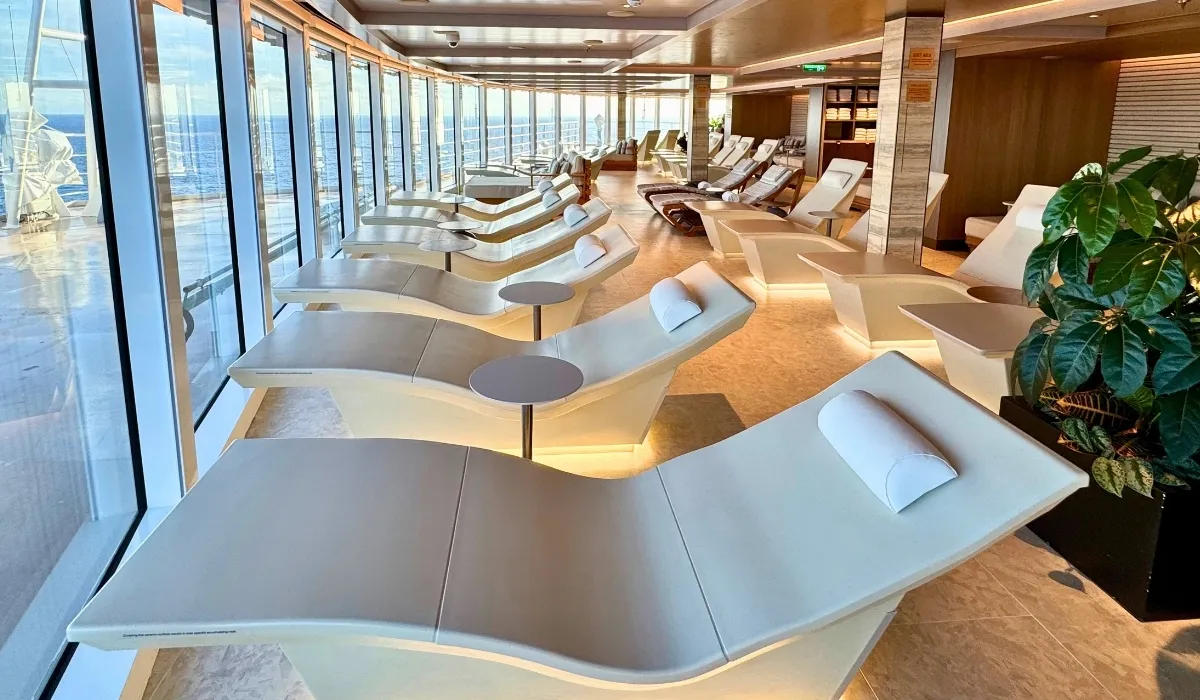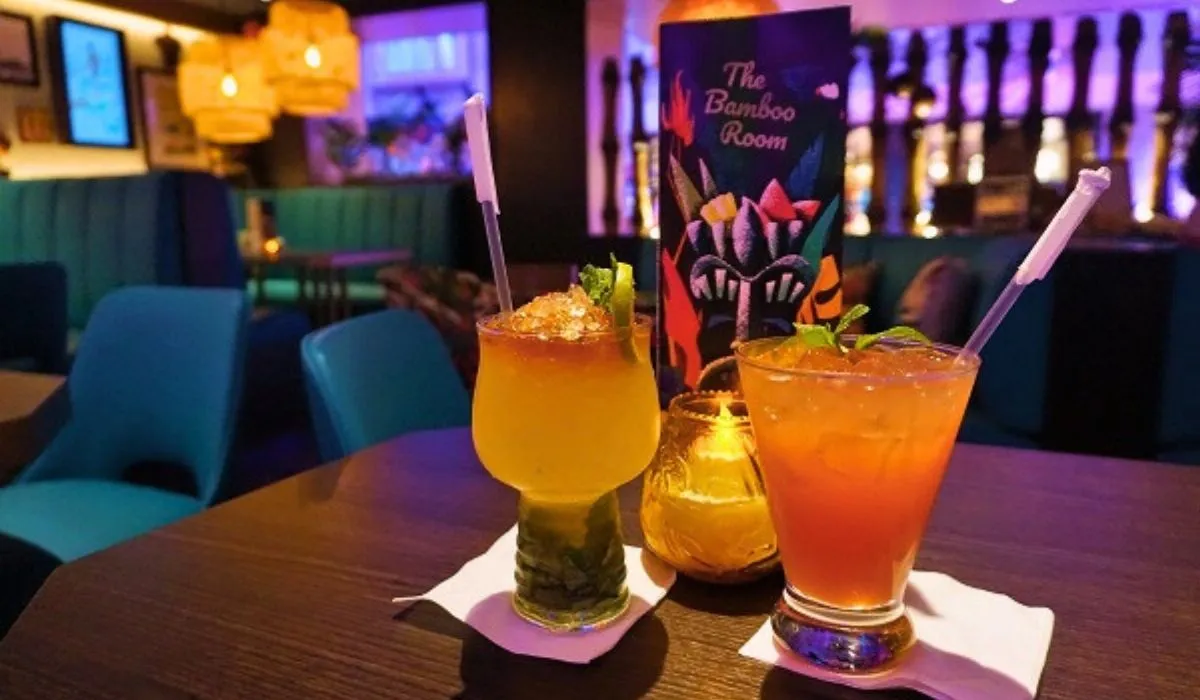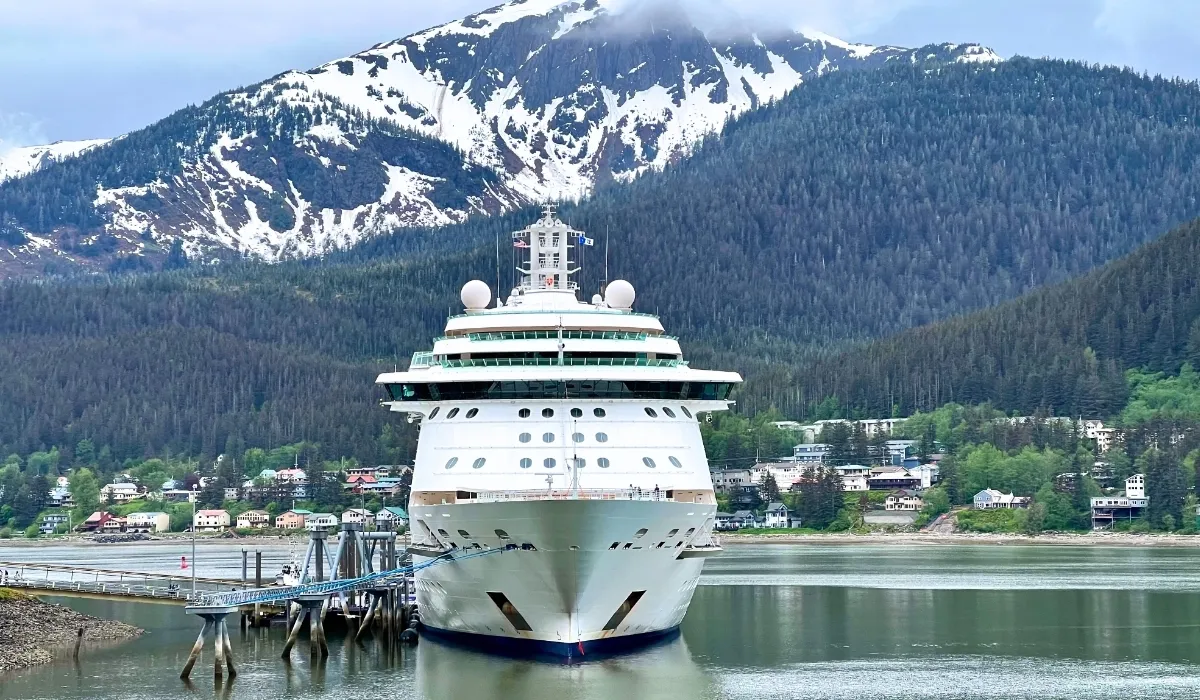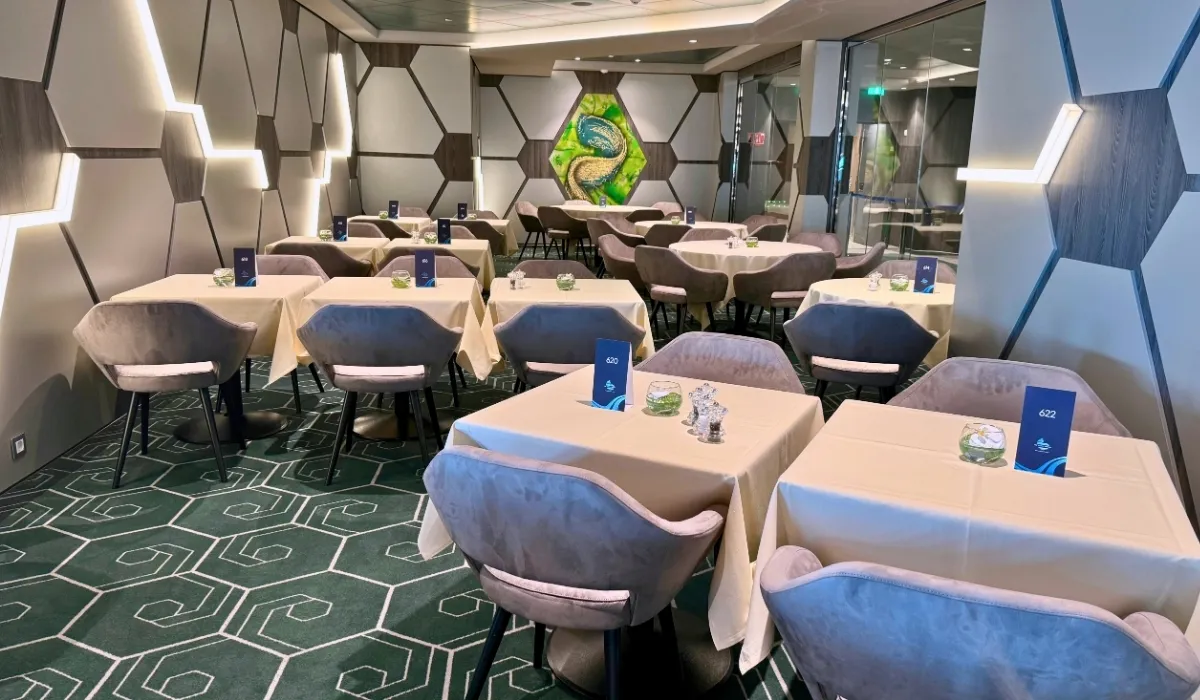Alaska cruises offer some of the most breathtaking scenery and unique experiences in the world. From magnificent glaciers to abundant wildlife and charming port towns, an Alaska cruise vacation should be on everyone’s bucket list. However, planning the perfect Alaska cruise can feel overwhelming with so many considerations. Having cruised to Alaska six times now, we answer the most frequently asked Alaska cruise questions to help you plan your dream vacation to the Last Frontier.
Table of Contents
- Basic/Planning Alaska Cruise Questions
- More Specific Alaska Cruise Questions
- Alaska Cruise Itinerary Questions
- Alaska Cruise Weather Related Questions
- Alaska Cruise Packing Questions
- Alaska Cruise Wildlife Questions
- Alaska Cruise Glacier Related Questions
- Alaska Cruise Shore Excursions Questions
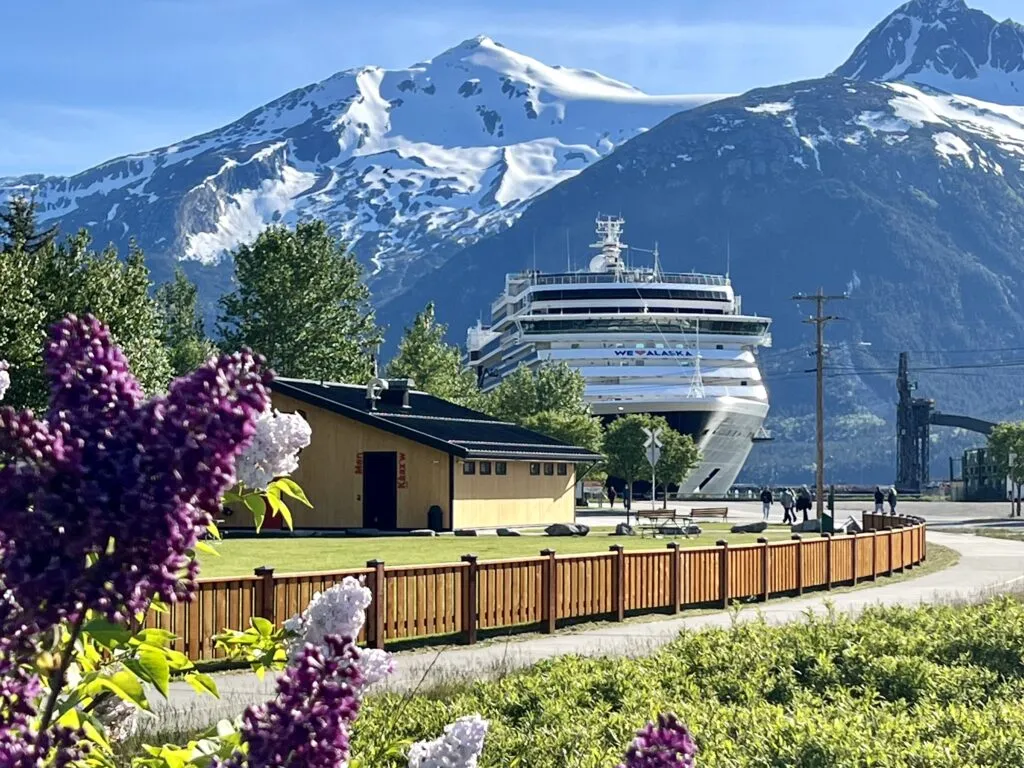
Your Top 75 Alaska Cruise Questions Answered!
As someone who has been on nearly 100 cruises (including Alaska!), we’ve heard just about every question when it comes to sailing the region. In this post, we’re answering the top Alaska cruise questions to help you feel confident and prepared for your adventure. Whether you’re wondering about excursions, wildlife sightings, or how cold it really gets, we’ve got you covered.
Basic/Planning Alaska Cruise Questions
1. When is the best time to cruise to Alaska?
The Alaska cruise season runs from May to September, with each month offering different advantages. Mid-June to mid-August provides the warmest temperatures (averaging 50-70°F) and longest daylight hours, perfect for outdoor activities. May and September offer lower prices and fewer crowds, though temperatures are cooler.
Wildlife viewing is excellent throughout the season, with peak whale activity in June and July. Bear viewing peaks in July and August during salmon runs. September offers beautiful fall colors and possible Northern Lights sightings, while May features blooming wildflowers. Consider your priorities—budget, weather, or specific experiences—when choosing your cruise date.
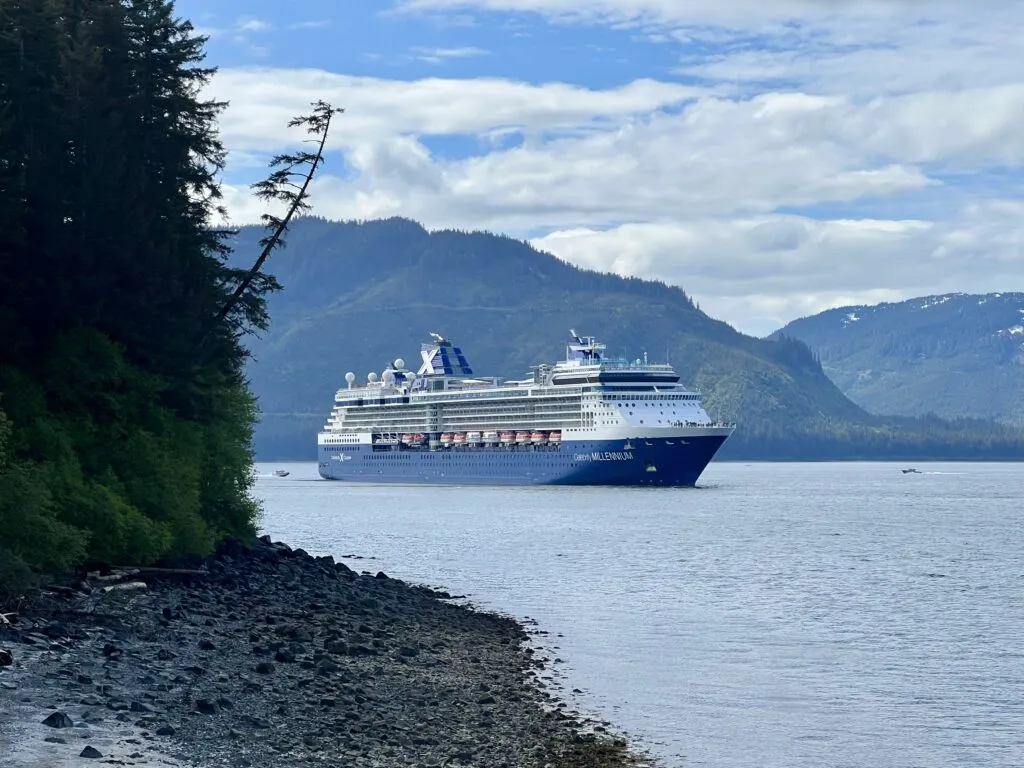
2. How much does an Alaska cruise typically cost?
Alaska cruise prices vary widely depending on several factors. Entry-level interior cabins on mainstream cruise lines typically start around $600-$1,200 per person for a 7-day sailing, while oceanview cabins range from $900-$1,800 and balconies from $1,200-$2,500. Luxury lines and premium suites can exceed $5,000 per person. Shoulder season cruises can offer savings of 20-30% compared to peak summer rates.
These base prices include accommodation, meals at main dining venues, basic entertainment, and transportation between ports. Additional costs include gratuities, shore excursions, specialty dining, drinks, WiFi, and flights to your embarkation port.
All said and done, it’s reasonable to budget $10K for a couple and more for families.
3. How long are Alaska cruises?
Most Alaska cruises range from 7 to 14 days. Seven-day itineraries are the most common and typically sail either roundtrip from Seattle/Vancouver or one-way between Vancouver and Seward/Whittier (Anchorage). These week-long cruises usually visit 3-4 ports plus glacier viewing.
Ten to 14-day cruises offer more comprehensive experiences, often including less-visited ports. For the most immersive experience, consider cruisetour packages that combine a 7-day cruise with 3-7 days of land touring in Alaska’s interior, including Denali National Park.
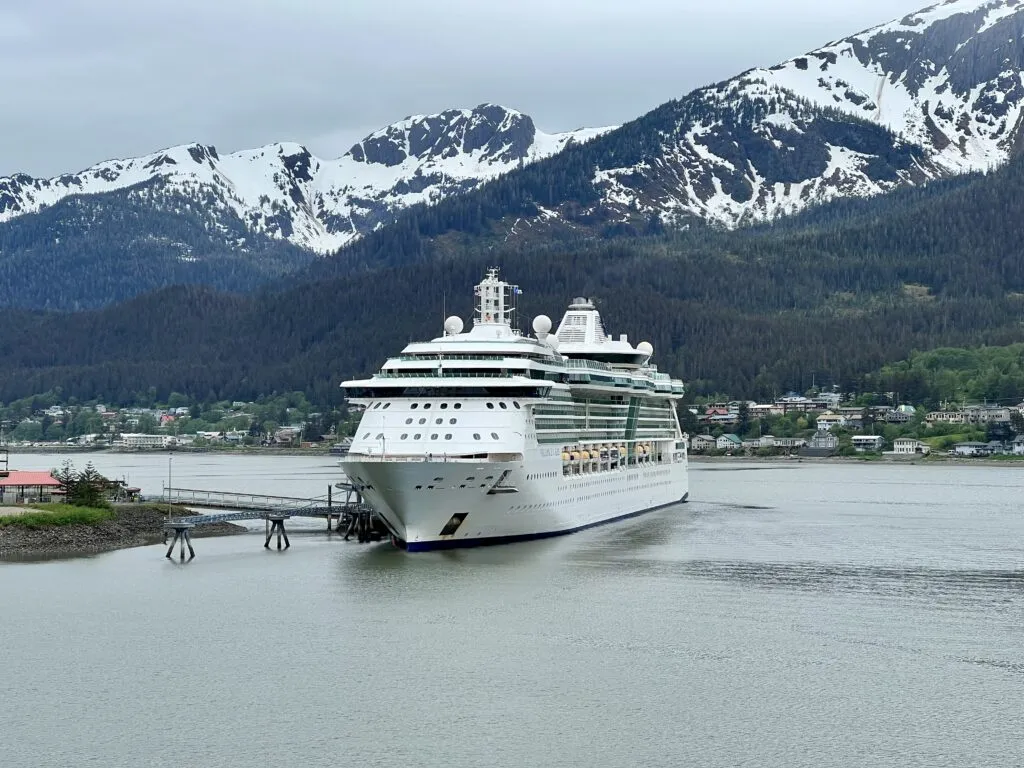
4. What’s the difference between northbound and southbound Alaska cruises?
Northbound and southbound Alaska cruises are one-way itineraries typically sailing between Vancouver, BC and either Whittier or Seward, AK (near Anchorage). The actual ports visited are nearly identical regardless of direction—the primary difference is the order in which you experience them.
Northbound cruises begin in Vancouver and end in Alaska, making them ideal for adding a post-cruise land tour to Denali or Alaska’s interior. Southbound cruises start in Alaska and end in Vancouver, better for pre-cruise land tours. Your choice should depend on flight convenience from your home city, whether you prefer doing land tours before or after your cruise, and specific sailing dates available.
5. What cruise lines go to Alaska?
Nearly every major cruise line operates in Alaska during the May-September season. Premium and mainstream options include Princess, Holland America, Royal Caribbean, Norwegian, Celebrity, Carnival, and Disney Cruise Line. These lines typically offer 7-day itineraries on larger ships at more affordable price points. Luxury lines sailing Alaska include Silversea, Seabourn, Regent Seven Seas, Viking, and Oceania, featuring smaller ships with higher staff-to-guest ratios and more all-inclusive pricing.
For a more intimate experience, small-ship expedition companies like UnCruise Adventures, Lindblad Expeditions, HX, and Alaskan Dream Cruises operate vessels carrying 40-100 passengers that can access places that larger ships can’t reach.
Holland America and Princess are particularly established in Alaska, with exclusive lodges and extensive land programs.
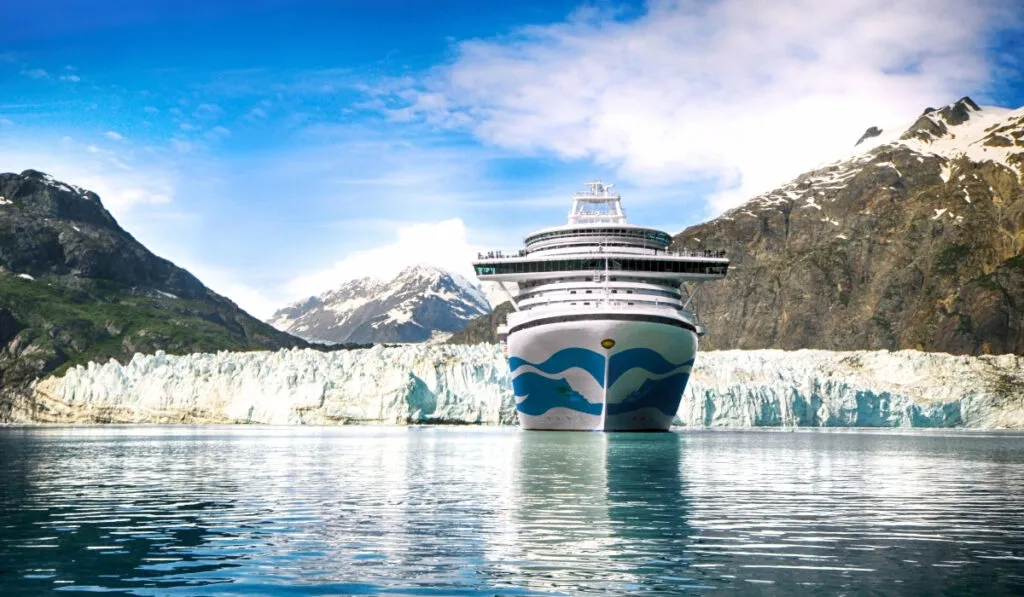
6. Should I choose a large ship or small ship for Alaska?
This all depends on your preferences. Large ships (2,000+ passengers) offer more amenities, entertainment options, dining venues, and typically lower prices. These mainstream vessels provide comfortable viewing of major glaciers and visit popular ports, but can’t access narrow fjords or remote areas.
Small ships (under 200 passengers) provide intimate experiences, flexible itineraries that can change for wildlife sightings, and access to wilderness areas and tiny ports inaccessible to larger vessels. These expedition-style cruises focus on education and outdoor activities. But the onboard experience, including accommodations and dining, won’t be as glamourous.
7. How rough are the waters on an Alaska cruise?
Alaska cruises generally experience calm waters, particularly on Inside Passage routes. The most potentially rough sections include the open water crossing between Seattle and Vancouver Island (for Seattle departures), and the Gulf of Alaska (for one-way cruises between Vancouver and Seward/Whittier). Even in these areas, summer conditions are typically mild compared to other cruise regions.
If you’re prone to seasickness, book an Inside Passage roundtrip cruise from Vancouver for the calmest experience, choose a mid-ship cabin on a lower deck where motion is less noticeable, and bring preventative medication just in case.
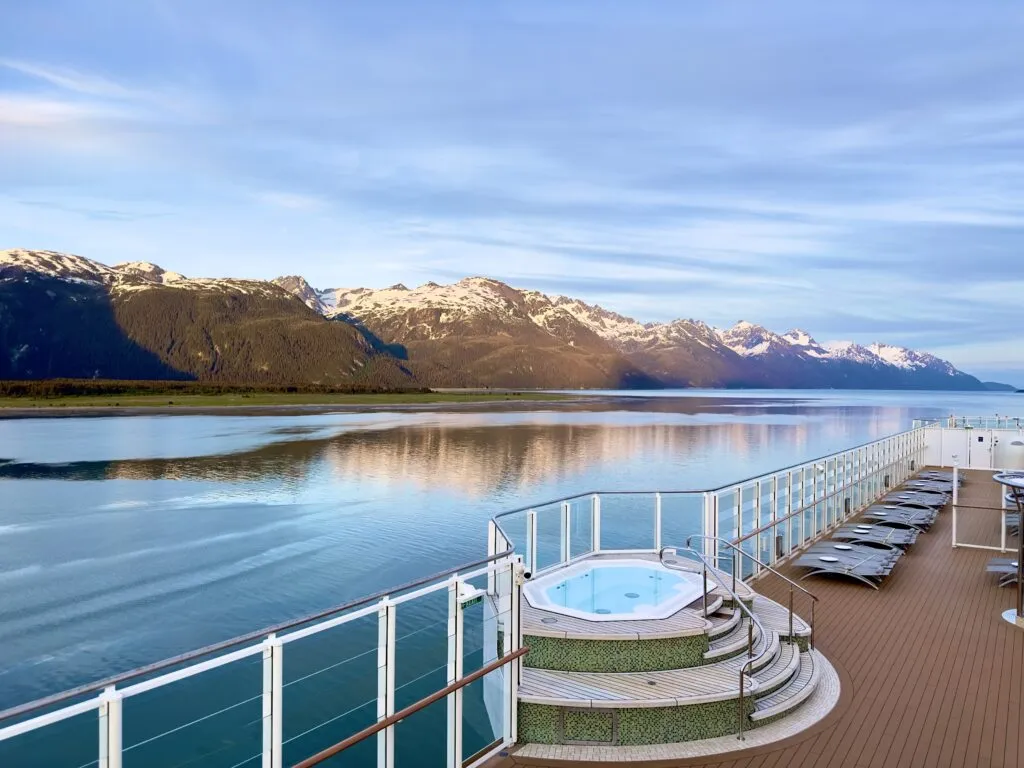
8. When is the best time to book an Alaska cruise?
For optimal selection and pricing, book your Alaska cruise 9-12 months in advance, particularly if you want specific cabin categories, sailing dates during peak season, or popular ships. Alaska’s short May-September season creates high demand, with the best deals typically available during “wave season” (January-March) when cruise lines offer early booking incentives.
Last-minute deals (30-60 days before sailing) occasionally appear but usually only for less desirable cabins or sailings.
9. Do I need a passport for an Alaska cruise?
Passport requirements depend on your cruise itinerary and citizenship. U.S. citizens on closed-loop cruises (departing and returning to the same U.S. port, like roundtrip Seattle) technically can travel with just a government-issued photo ID and birth certificate. However, a passport is strongly recommended even for these itineraries as it’s required if you need to fly home unexpectedly due to an emergency.
All one-way cruises or cruises departing from or returning to Vancouver absolutely require a passport for all passengers, regardless of citizenship. Non-U.S. citizens must have a passport and appropriate visas for all cruise itineraries, even closed-loop voyages. Additionally, some shore excursions cross into Canada (like Skagway’s White Pass Railway), requiring proper documentation.
10. What are cruisetours and are they worth it?
Cruisetours combine an Alaska cruise with a land package, typically including Denali National Park, Fairbanks, and sometimes the Yukon. These 10-14 day packages offer the benefit of experiencing Alaska’s spectacular coastline and wilderness interior in one vacation. The land portion utilizes scenic railroads, motor coaches, and stays at wilderness lodges.
Cruisetours are worth the extra time and money if you want a comprehensive Alaska experience, as the interior offers dramatically different landscapes and wildlife than coastal areas. Princess and Holland America operate their own lodges, while other cruise lines partner with local operators.

11. Where can I find deals on Alaska cruises?
As mentioned previously, for the best Alaska cruise deals, we recommend booking 9-12 months in advance during “wave season” (January-March). Early booking incentives can include things like reduced deposits, onboard credit, or included gratuities. For actual price reductions, look for May and September departures or less popular ships.
Travel advisors specializing in cruises often access exclusive promotions, group rates, and value-added perks. Additionally, cruise line loyalty programs often reward past passengers with booking discounts, while resident specials benefit those in specific states (especially Washington, Oregon, and California for Alaska sailings).
More Specific Alaska Cruise Questions
12. Should I book a balcony cabin for an Alaska cruise?
A balcony cabin significantly enhances the Alaska cruise experience. While a hotly debated topic, we believe it is worth the investment if your budget allows. Alaska’s scenery is the main attraction, with stunning views of glaciers, fjords, and possible wildlife sightings throughout the day.
While interior and oceanview cabins are more affordable, they limit your scenic viewing to public decks, which can become crowded during prime scenic cruising. If a balcony exceeds your budget, an oceanview cabin offers a middle-ground solution.
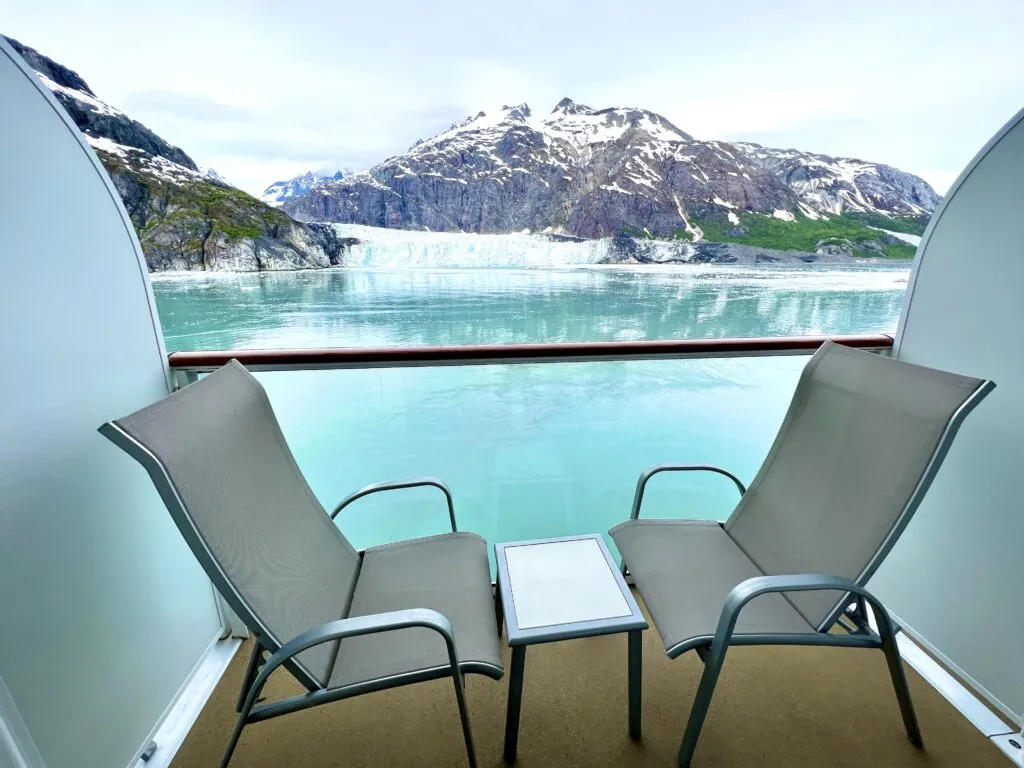
13. Which side of the ship is better for an Alaska cruise?
Neither starboard nor port side consistently offers better views throughout an Alaska cruise, as the best viewing opportunities alternate depending on your itinerary. During glacier viewing, ships typically rotate 360° ensuring all sides get optimal views.
Rather than focusing exclusively on cabin location, consider alternatives like booking a balcony aft cabin (rear) for wrap-around views; utilizing public observation lounges during scenic cruising; and exploring both sides of the ship during key sailings through fjords.
14. Are Alaska cruises good for families with children?
Alaska cruises offer excellent family experiences with activities appealing to all ages. Kids will enjoy wildlife spotting (whales, eagles, bears), glacier viewing with calving ice, and adventurous excursions like dog sledding or zip-lining. Most large cruise lines operating in Alaska offer structured youth programs divided by age groups with Alaska-themed activities, science projects, and junior ranger programs.
For families, choose ships with amenities like pools, sports courts, and dedicated kids’ spaces. Though Alaska cruises cost more than Caribbean alternatives, they provide unique educational experiences that create lasting family memories.
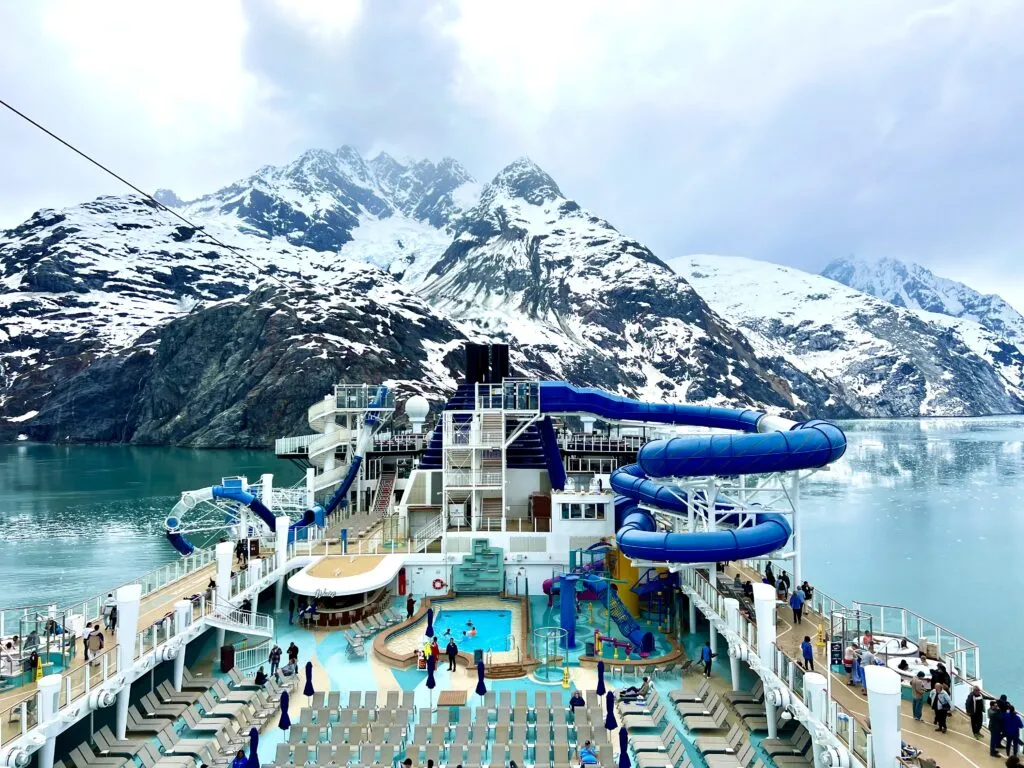
15. Will my cell phone work in Alaska?
Cell phone coverage in Alaska is improving but remains limited compared to the lower 48 states. In major ports like Juneau, Ketchikan, and Skagway, most major U.S. carriers (Verizon, AT&T, T-Mobile) provide reliable service, though coverage may be limited to 3G in some areas. Once your ship leaves port, service quickly disappears until the next destination.
Before traveling, check your carrier’s Alaska coverage map and international roaming charges, as some plans treat Alaska differently despite it being a U.S. state. Further, most cruise lines offer onboard WiFi packages to stay connected while on the ship.
16. Will I see the Northern Lights on my Alaska cruise?
Seeing the Northern Lights (Aurora Borealis) during a typical Alaska cruise season (May-September) is unlikely due to extended daylight hours. The midnight sun of summer creates too much light for aurora visibility. Your best chance would be on September sailings, particularly late in the month when darkness returns and skies clear.
For serious aurora viewing, consider extending your trip with a land tour to Alaska’s interior (Fairbanks area) in late September. In general, if aurora viewing is a primary goal, an Alaska cruise during the standard season isn’t your best option. Instead, plan a dedicated winter trip to interior Alaska, northern Canada, Iceland, or Norway.
17. Can I see the midnight sun on an Alaska cruise?
While Alaska cruise routes don’t reach the Arctic Circle (where the true midnight sun phenomenon occurs), you’ll experience remarkably long daylight hours during summer sailings. In June and early July, ports like Juneau and Skagway receive 18+ hours of daylight with extended twilight during the brief “night” period.
If experiencing the genuine midnight sun (where the sun never sets) is a priority, consider adding a post-cruise land tour to Fairbanks, which receives 22+ hours of daylight in late June despite being slightly south of the Arctic Circle.

18. Do I need travel insurance for an Alaska cruise?
Travel insurance is strongly recommended for Alaska cruises, as well as all cruises. The remote nature of Alaska’s ports means medical evacuations can be pricy and expenses are not covered by most health insurance plans. Weather disruptions frequently cause flight delays to embarkation ports, making missed cruise coverage valuable.
Comprehensive policies should include coverage for trip cancellation/interruption, medical expenses, emergency evacuation, baggage protection, and ideally “cancel for any reason” provisions. When selecting coverage, verify pre-existing condition waivers if needed, and confirm coverage for excursion activities like helicopter rides or adventure sports.
You’ll want to purchase insurance promptly after making your initial cruise deposit to ensure coverage eligibility. Pre-existing condition waivers typically require purchase within 14-21 days of initial trip payment.
19. Should I arrive at my departure port a day early?
Yes! Arriving at your departure port at least one day before your cruise is highly recommended for Alaska sailings. This buffer provides crucial protection against flight delays, cancellations, or weather disruptions. Seattle and Vancouver experience summer fog delays, while Anchorage connections to Whittier/Seward can face weather challenges too.
Not to mention, pre-cruise days allow for jet lag recovery, exploration of departure cities, and stress-free embarkation.
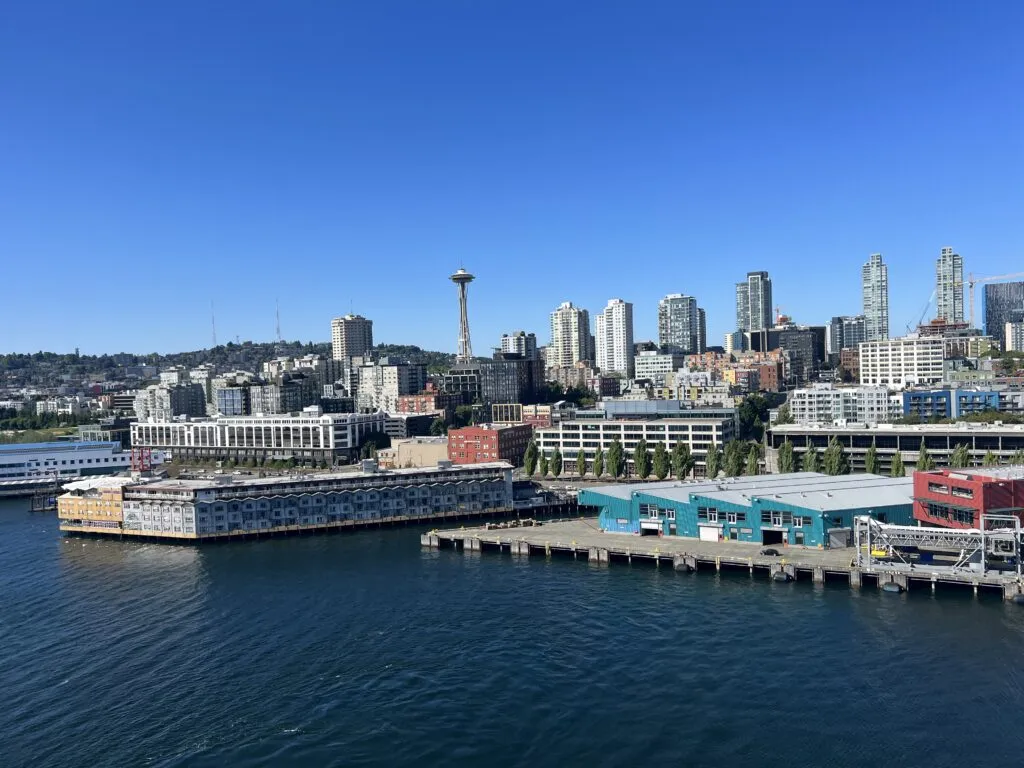
20. What’s included on an Alaska cruise?
Like any cruise, a standard Alaska cruise fare includes your cabin accommodation, main dining room meals, a buffet and other casual food options, basic beverages (water, coffee, tea, lemonade), entertainment (shows, lectures, music), various other onboard amenities and activites, and kids’ programs. Most cruise lines also include scenic glacier viewing with onboard commentary.
However, some other items are up-charges. These include alcoholic beverages, specialty dining restaurants, specialty coffees, shore excursions, gratuities, spa treatments, internet access, and shopping. Photos, casino gaming, and certain onboard activities also incur extra charges.
21. Are there luxury Alaska cruises?
Yes, luxury cruise lines operate in Alaska, offering premium experiences with smaller ships (typically 200-900 passengers), expanded suite accommodations, and all-inclusive pricing. Top luxury options include Regent Seven Seas, Silversea, Seabourn, Viking, and Oceania.
These vessels provide exceptional staff-to-guest ratios, gourmet dining, included fine wines and premium spirits, and sophisticated onboard enrichment programs. Further, the smaller ship size allows access to less-visited ports and more intimate glacier viewing opportunities.
22. What’s the cheapest month to cruise to Alaska?
May and September, the “shoulder season”, consistently offer the lowest prices, with savings of 20-40% compared to peak summer rates. Late April into early May and late September into early October provide the very best deals, as these sailings coincide with cooler temperatures, increased chances of rain, and the beginning/end of seasonal operations in port towns.
Besides reduced cruise fares, these periods offer additional savings through less expensive airfare, sometimes reduced excursion prices with local operators, and end-of-season sales in port shops.
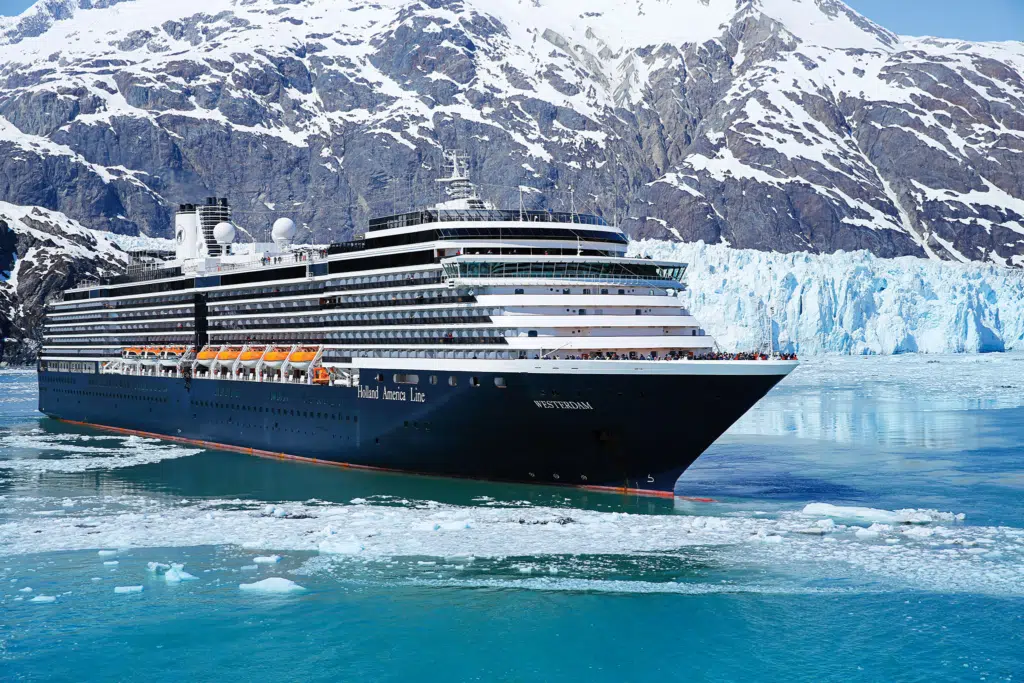
23. Are casinos open on an Alaska cruise?
Cruise ship casinos operate on Alaska itineraries with specific timing restrictions. Casinos must remain closed while in Alaskan waters to comply with state gambling regulations. Consequently, casinos are closed during scenic cruising days when ships remain near coastlines, closed while docked in ports, and closed during extended sailing through narrow passages.
However, casinos open during sea days when the ship travels beyond territorial waters, during overnight sailings across the Gulf of Alaska, and sometimes during longer stretches between ports. The casino schedule is published in daily programs, allowing interested passengers to plan accordingly.
24. Can I cruise to Alaska with a DUI?
A past DUI conviction can significantly impact your Alaska cruise plans. Canada maintains strict entry restrictions regarding DUI convictions, potentially denying entry to travelers with a history regardless of how long ago the offense occurred. This primarily affects cruises departing from Vancouver and one-way sailings between Alaska and Vancouver.
Travelers with a single DUI conviction may apply for “criminal rehabilitation” clearance from the Canadian government, though approval isn’t guaranteed and applications should be submitted months before travel. For those unable to obtain Canadian clearance, roundtrip cruises from Seattle are an alternative. While these itineraries must still make a stop in Canada to comply with maritime regulation, passengers with DUI records can just remain on the ship.
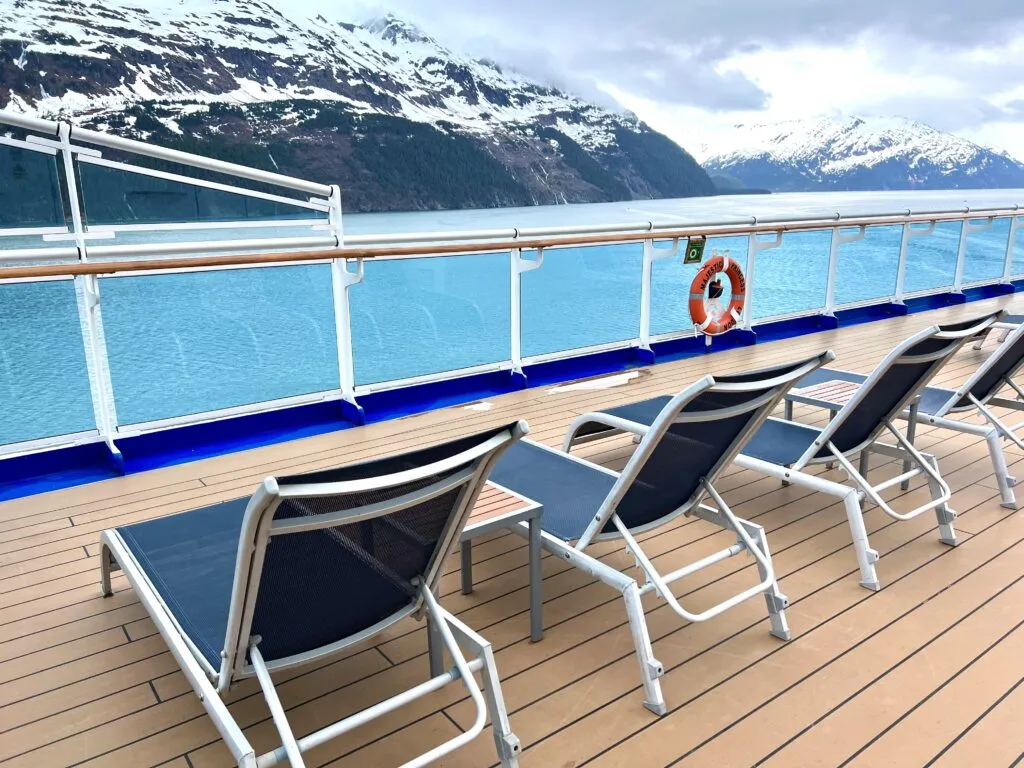
25. Is seasickness common on Alaska cruises?
Seasickness is significantly less common on Alaska cruises compared to other itineraries, particularly on Inside Passage routes where ships travel through sheltered waterways between islands and the mainland. Most passengers experience little to no motion-related discomfort throughout their sailing. The two exceptions are crossing between Seattle and Vancouver Island’s protected waters (on Seattle departures) and Gulf of Alaska crossings (on one-way itineraries between Vancouver and Seward/Whittier). Though, modern cruise ships have advanced stabilizer systems that effectively minimize motion even in these areas.
For passengers with known motion sensitivity, preventative measures include booking midship cabins on lower decks where movement is least noticeable, bringing motion sickness medications, and considering acupressure wristbands or ginger supplements as natural alternatives.
26. What’s the time difference in Alaska?
Alaska operates on Alaska Standard Time (AKST), which is 4 hours behind Eastern Standard Time, 3 hours behind Central, 2 hours behind Mountain, and 1 hour behind Pacific. During summer cruise season, Alaska observes daylight saving time (Alaska Daylight Time or AKDT), maintaining these same relationships with other U.S. time zones.
27. Are Alaska cruises suitable for people with mobility issues?
Alaska cruises can accommodate passengers with mobility issues, though with certain limitations when it comes to ashore activities. Modern cruise ships offer accessible cabins, elevators to all passenger decks, and wheelchair-friendly public areas. For port visits, larger ships typically dock directly at accessible piers in major ports like Juneau, Ketchikan, and Skagway, though smaller ports sometimes require tendering which can be challenging for wheelchair users or those with significant mobility limitations.
The greater challenge comes with shore excursions as Alaska’s rugged terrain makes many popular activities inaccessible to those with mobility concerns. However, cruise lines increasingly offer designated “accessible excursions” with transportation and experiences specifically designed for those with mobility limitations.
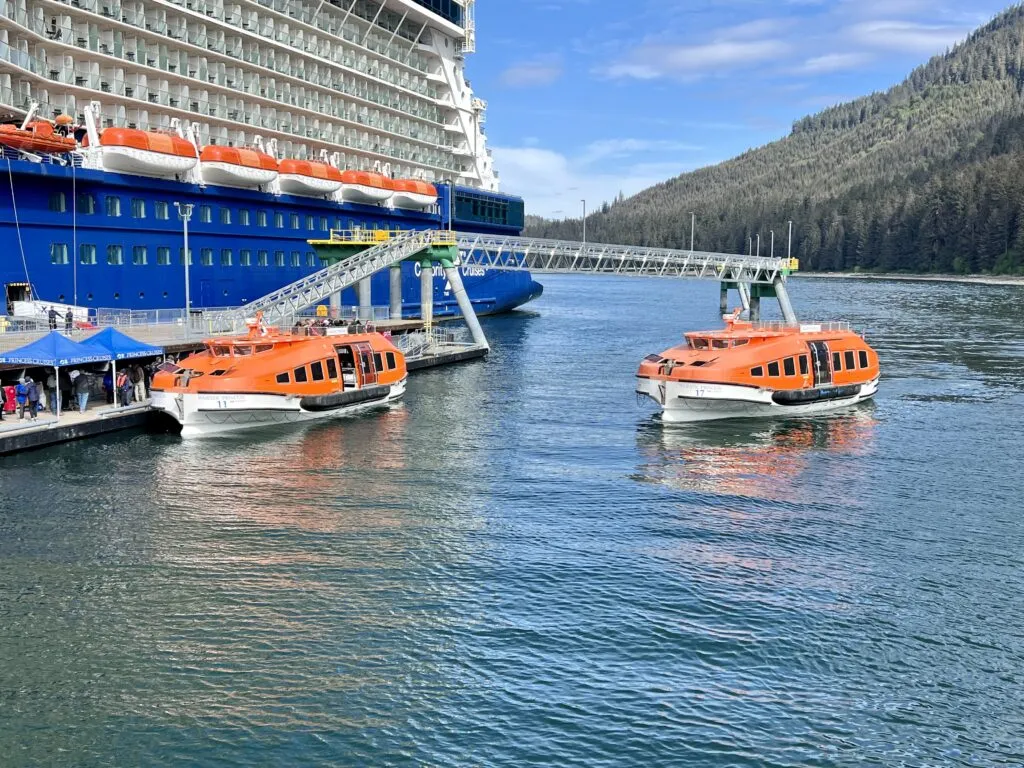
28. Are Alaska cruises good for solo travelers?
Alaska cruises, and cruises in general, are a great option for solo travelers. The destination naturally fosters shared experiences like whale watching, glacier viewing, and wildlife sightings, and shore excursions provide automatic social groups with shared interests. Most cruise lines also organize solo traveler meetups early in the voyage.
The primary challenge for solo cruisers is the “single supplement” pricing that typically charges 150-200% of the per-person double occupancy rate for solo cabin use. To address this, several cruise lines including Norwegian, Royal Caribbean, and Holland America now offer dedicated solo cabins priced for single occupancy on select ships.
29. Is the food different on Alaska cruises?
Alaska cruises often feature regional cuisine unavailable on other itineraries. Fresh local seafood is on all menus, with many cruise lines partnering with local suppliers for seasonal specialties. Beyond seafood, you’ll find other regional touches like local berries in desserts and Alaskan craft beers in ship bars.
Certain cruise lines embrace Alaska’s culinary options more extensively (Holland Amreica and Princess Cruises), incorporating local ingredients and unique experiences.
30. What’s there to do onboard Alaska cruises?
Onboard activities on Alaska cruises emphasize the destination more than on tropical itineraries. On many cruise lines, naturalists offer daily presentations about wildlife, glaciers, and native cultures, while park rangers board ships in Glacier Bay providing expert commentary. Other Alaska-focused enrichment can include demonstrations of gold panning, totem carving, or even “Puppies in the Piazza” on Princess Cruises. For wildlife viewing, dedicated observation lounges are popular gathering spots, particularly during scenic cruising of fjords and glacier areas.
Beyond Alaska-specific programming, these ships have all the standard offerings—fitness centers, spas, pools, production shows, casinos, bars and lounges with live music, and so much more. More family-friendly cruise lines in Alaska even offer activities like sky-diving simulators and race tracks.
So, while the general vibe is more relaxed, there’s still plenty to do between ports of call.
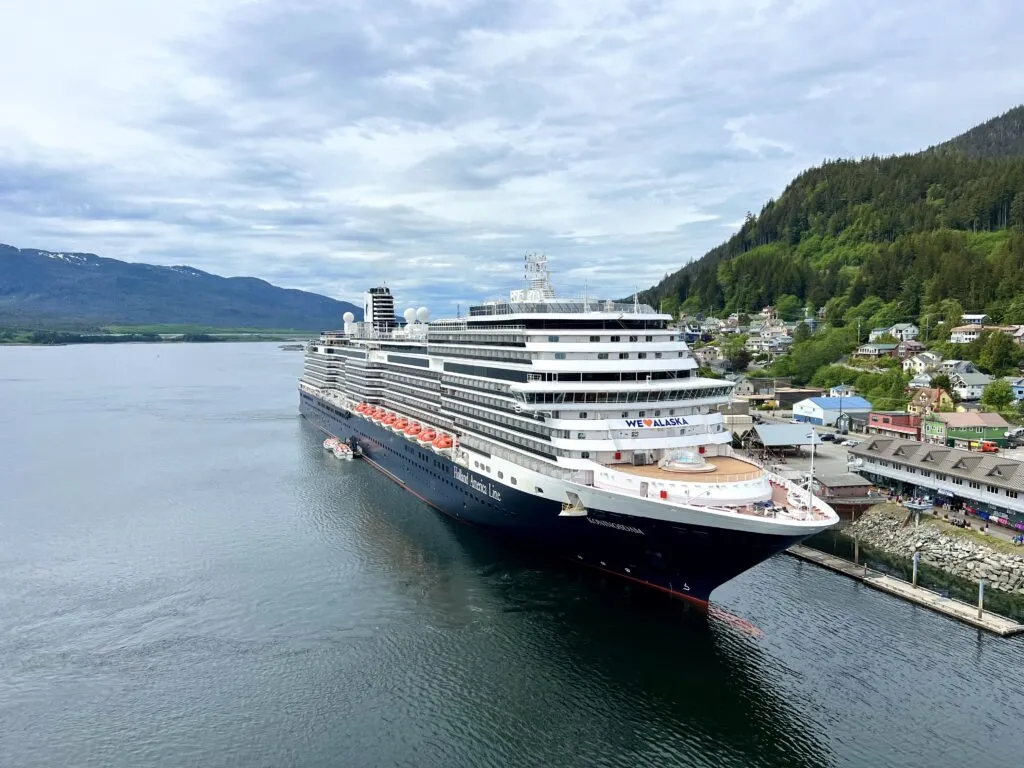
31. How are Alaska cruises different from Caribbean cruises?
Alaska and Caribbean cruises offer fundamentally different vacation experiences. Alaska cruises focus on natural beauty and wildlife with considerable time devoted to scenic cruising and enrichment opportunities. The demographic skews a bit older with fewer children except during summer school breaks. Alaska’s cooler weather shifts activities from poolside to observation lounges.
Shore excursions emphasize outdoor adventures rather than beaches and water sports, with significantly higher average excursion prices. Dress codes remain more casual in Alaska with practical layered clothing replacing sundresses and shorts.
Alaska Cruise Itinerary Questions
32. Which Alaska cruise ports are most popular?
The most visited Alaska cruise ports include Juneau, Alaska’s capital, known for the Mendenhall Glacier; Skagway, a Gold Rush town offering the scenic White Pass & Yukon Route Railway; Ketchikan, famous for its totem poles, Creek Street, and nearby Misty Fjords National Monument; and Sitka, with its unique Russian heritage.
Most itineraries also include scenic cruising in Glacier Bay National Park, Tracy Arm Fjord/Endicott Arm, or Hubbard Glacier. Less common but notable ports include Icy Strait Point (Hoonah), an authentic Native Tlingit village; Haines, known for eagle viewing and outdoor adventures; and Wrangell, offering genuine Alaska experiences without crowds.

33. What is the Inside Passage?
The Inside Passage is a spectacular coastal route weaving through islands along Southeast Alaska and British Columbia. This sheltered waterway stretches approximately 1,000 miles from Seattle/Vancouver to Skagway, protecting ships from open ocean conditions while offering breathtaking scenery of mountains, forests, and abundant wildlife. Its unique geography concentrates marine life, making whale and porpoise sightings common.
Originally charted by early explorers seeking the Northwest Passage, today it serves as the primary route for most Alaska cruises. Key destinations along the Inside Passage include Ketchikan, Juneau, Skagway, and numerous fjords and wilderness areas.
34. Where do Alaska cruises depart from?
Alaska cruises primarily depart from four gateway cities. Seattle, Washington offers the most convenient option for most Americans with abundant domestic flights and no passport requirement for U.S. citizens on roundtrip sailings. Vancouver, Canada provides the most scenic departure directly into the Inside Passage, avoiding open ocean crossings, though requiring passports for all passengers.
For one-way Gulf of Alaska itineraries, guests will depart from either Vancouver (southern port) or Whittier/Seward (northern ports). Whittier is 1.5 hours from Anchorage, while Seward is 2.5 hours from Anchorage. Less common departure points include San Francisco (longer cruises) and Sitka or Juneau (small expedition vessels only).
35. How do I choose between cruising from Seattle or Vancouver?
Seattle offers easier, often cheaper flights for Americans, no passport requirements for US citizens, and simpler logistics. However, it does require crossing open waters to reach Alaska and an international stop in Victoria to satisfy maritime regulations. Vancouver provides a more scenic departure through the Inside Passage from day one, smoother waters, and direct sailing to Alaska without required stops. Though, US citizens need passports for Vancouver departures.
Both cities warrant pre/post-cruise stays, with Vancouver offering Stanley Park, Granville Island, and mountain surroundings, while Seattle features Pike Place Market, the Space Needle, and vibrant neighborhoods.
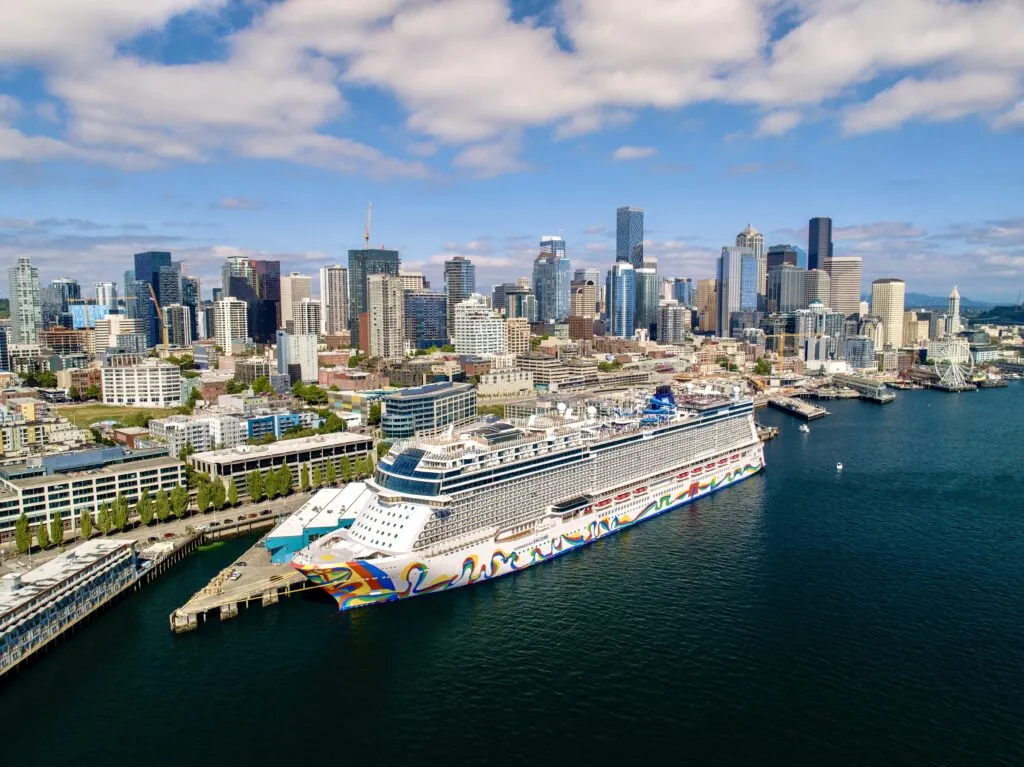
36. Can I see Denali (Mt. McKinley) on my cruise?
Denali (formerly Mt. McKinley), North America’s highest peak, is not visible from any standard cruise route. The mountain is approximately 200 miles inland from Alaska’s southern coast. To experience Denali, you’ll need either a cruise-tour package or a post-cruise independent arrangement to the interior.
A typical Denali visit requires 3-4 days beyond your cruise, including scenic railroad trips and bus tours into the park interior where wildlife viewing and possible mountain sightings occur. The mountain itself is visible only about 30% of summer days due to cloud cover.
37. What’s the best way to get to the cruise port in Seattle?
Seattle offers multiple transportation options to its two cruise terminals: Bell Street Pier (Pier 66) downtown and Smith Cove (Pier 91) north of downtown. From Seattle-Tacoma International Airport, options include: cruise line transfers ($29-$39 per person, convenient but with set schedules); taxis ($50-$60, faster with flexible timing); rideshare services like Uber/Lyft ($35-$50 depending on time/demand); or the Link Light Rail to downtown ($3) plus a short taxi to the pier. When booking flights, allow at least 90 minutes from airport arrival to terminal transfer.
For passengers staying pre-cruise in downtown hotels, Bell Street Pier may be walkable with wheeled luggage, while Smith Cove requires taxi/rideshare ($10-$15 from downtown).
Post-cruise, taxis and rideshares are readily available at both terminals, though surge pricing can increase costs significantly during peak disembarkation times.
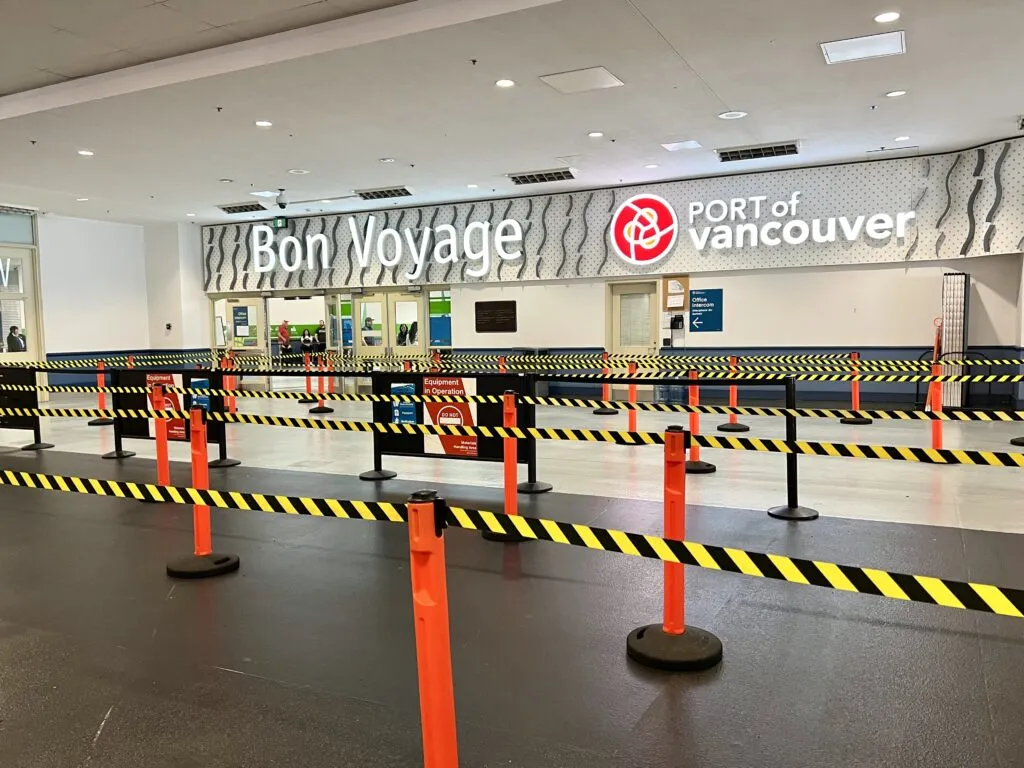
38. What’s the best way to get to the cruise port in Vancouver?
Vancouver’s Canada Place cruise terminal has a prime downtown location with several transportation options. From Vancouver International Airport (YVR), choices include: cruise line transfers ($25-$35 per person), taxis using regulated flat rates ($35-$40 to downtown), or the Canada Line SkyTrain ($9.25, running every 7 minutes). Remember that Vancouver requires passport documentation for all cruise passengers, so be sure to add in extra time when planning transfers.
For passengers staying at downtown hotels, many properties are within walking distance of Canada Place, while others are a short taxi ride away. The Fairmont Waterfront Hotel and Pan Pacific Hotel are popular choices.
Post-cruise, taxis queue outside the terminal, though waits can extend during peak disembarkation periods. The Canada Line provides efficient airport returns with trains departing from Waterfront Station.
39. Can I use Uber or Lyft in Alaska ports?
Rideshare availability in Alaska cruise ports is limited and inconsistent. Juneau is currently the only major port with reliable Uber and Lyft service. Ketchikan, Skagway, and Sitka generally lack consistent rideshare operations due to smaller populations and seasonal economies.
Alternative transportation options include abundant taxis waiting at all cruise piers, public buses in Juneau and Ketchikan, ship-sponsored shuttle services, and walking (Skagway and Ketchikan’s downtown areas are easily walkable from cruise docks).

40. What happens if my flight is delayed and I miss my cruise?
Missing your cruise due to flight delays creates a challenging situation that varies depending on your circumstances. Without travel insurance or cruise-line arranged flights, you’re responsible for arranging and funding transportation to the next port of call to join your ship. This can be extremely expensive in Alaska where some ports are accessible only by air or sea. Further, joining the ship mid-cruise can get particularly tricky, and may not even be possible, on Alaska cruises due to the Passenger Vessel Services Act.
So, that is why we always recommend that you plan to arrive at your departure city at least one day before the cruise’s embarkation day.
41. How do I get from Anchorage to Seward or Whittier?
Multiple transportation options connect Anchorage to its cruise terminals at Seward (125 miles south) and Whittier (60 miles southeast). The most seamless option is cruise line transfers ($60-89 per person each way). Other alternatives include the Alaska Railroad’s scenic Coastal Classic train to Seward ($115-224 one-way depending on class) or Glacier Discovery route to Whittier ($85-159).
Alternatively, guests can book private transfers (which we did) from their pre-cruise hotel to the terminal, with the potential for sightseeing along the way. Just keep in mind that Whittier requires passing through the 2.5-mile Anton Anderson Memorial Tunnel, which alternates one-way traffic hourly.
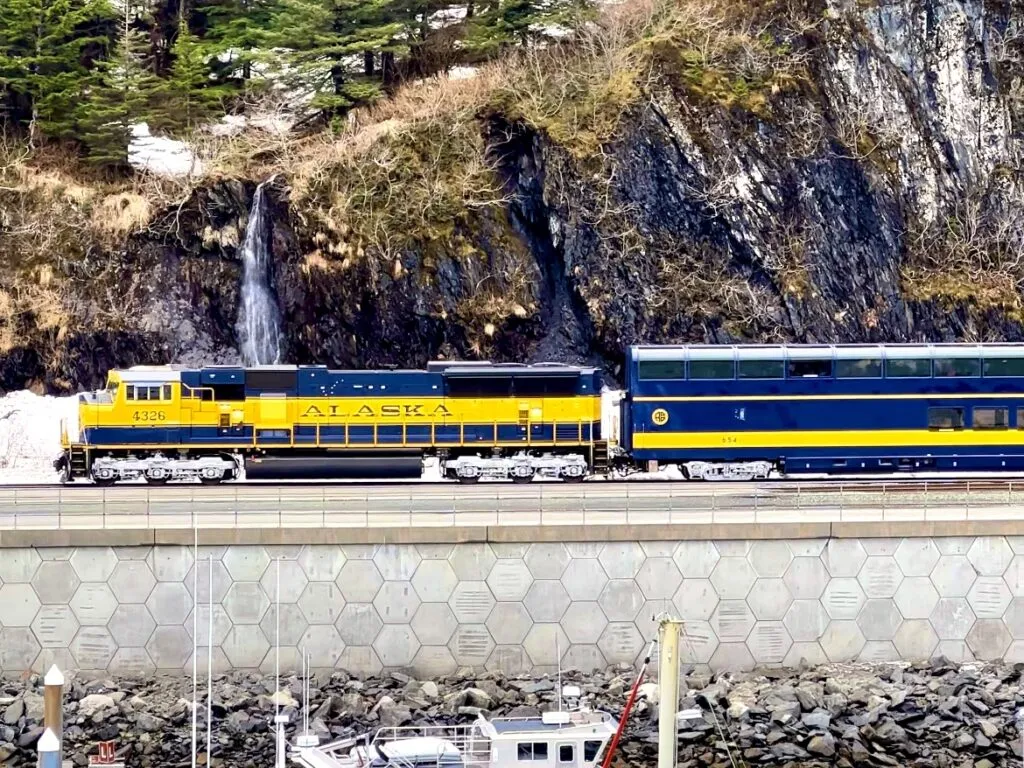
Alaska Cruise Weather Related Questions
42. What is the weather like on an Alaska cruise?
Alaska’s cruise season weather varies by month and location. May and September average 50-55°F with occasional dips into the 40s and highs in the 60s. June through August is warmer, typically 55-65°F with occasional 70°F days in port cities. Temperatures feel colder when viewing glaciers due to the microclimate they create.
Rain is common throughout the season, with Southeast Alaska receiving more precipitation than Whittier/Seward. September tends to be the wettest month, while May and June are typically drier. Though, conditions can change rapidly. You might experience sunshine, overcast skies, and rain showers all in the same day.
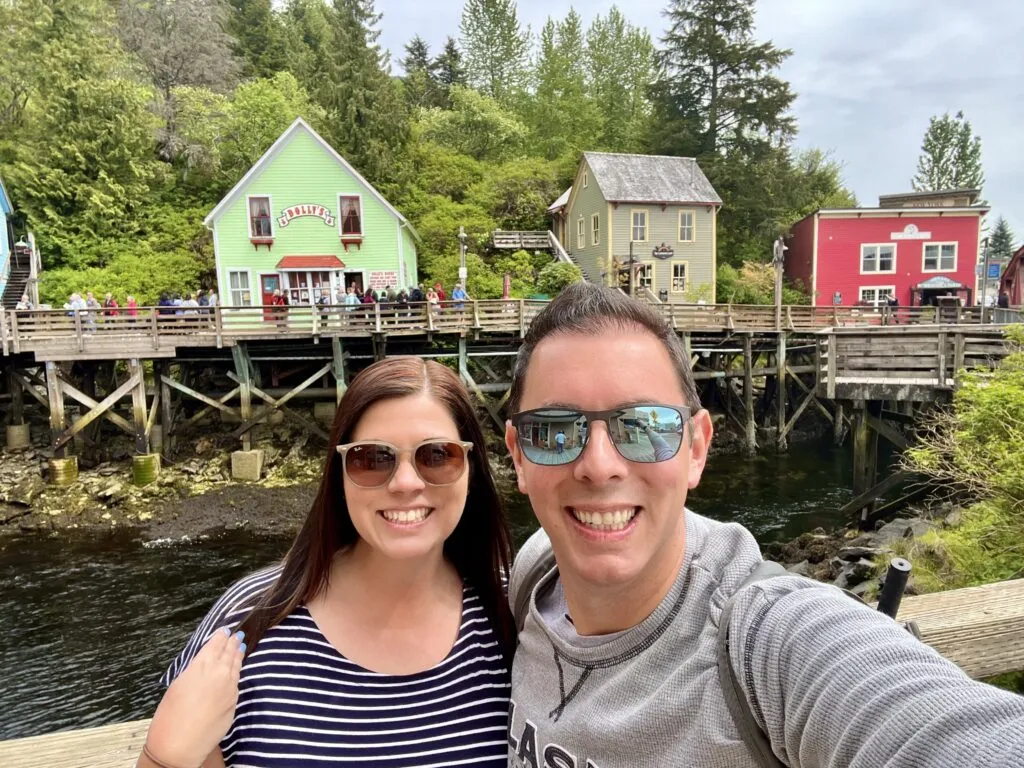
43. Will there be rain during my Alaska cruise?
Rain is likely during any Alaska cruise, regardless of timing. The Inside Passage (Juneau, Ketchikan, Skagway) is located in a temperate rainforest receiving 70-150 inches of annual precipitation. Statistically, May and June offer the driest conditions, while September sees the heaviest precipitation. However, Alaska rain tends to be more persistent light drizzle than heavy downpours.
Don’t let rain forecasts discourage you though, as “there’s no bad weather, only bad clothing”. Many shore excursions run rain or shine, and visitors often find that misty conditions enhance Alaska’s landscapes.
44. Will the weather impact scenic cruising or shore excursions on my Alaska cruise?
Unfortunately, the weather can impact both scenic cruising and shore excursions on an Alaska cruise.
Scenic cruising, such as Glacier Bay or Tracy Arm Fjord, is heavily influenced by weather conditions. Fog, rain, and low clouds can reduce visibility, making it harder to see glaciers and wildlife. However, overcast days can make glacier ice appear even more vibrant, and light rain doesn’t typically disrupt the experience. High winds, dense fog, or ice conditions may cause ships to alter routes or skip certain areas for safety reasons.
Shore excursions are also affected by Alaska’s unpredictable weather. Most excursions operate rain or shine, but strong winds, dense fog, or rough seas may lead to cancellations, especially for flightseeing, small boat tours, and kayaking trips.
Alaska Cruise Packing Questions
45. What should I pack for an Alaska cruise?
Pack for layering and variable weather with waterproof/windproof outer layers. You’ll need comfortable walking shoes, preferably waterproof, for excursions as well. Essential accessories also include a hat, gloves, sunscreen, and sunglasses.
For activities, pack a day backpack, binoculars for wildlife viewing, a camera with zoom lens, and a water bottle. Don’t forget cruise essentials like a swimsuit for hot tubs and motion sickness medication.
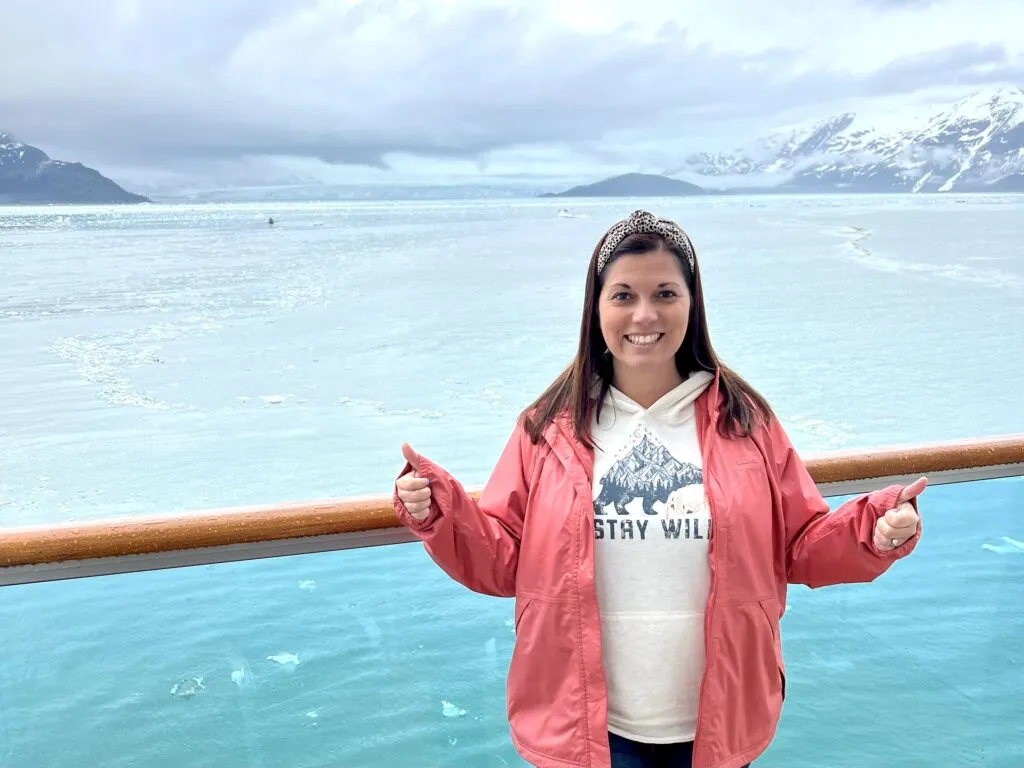
46. Do I need formal wear for an Alaska cruise?
Formal wear requirements vary significantly by cruise line. Luxury lines like Silversea or Cunard maintain elegant evening dress codes, while mainstream lines have become increasingly casual. Royal Caribbean, Celebrity, and Princess typically include 1-2 “formal” or “evening chic” nights on 7-day Alaska cruises, though these are more business casual than truly formal.
In general, Alaska cruises tend to be more casual than other itineraries given the destination’s outdoor focus. Pack versatile items like a simple dress or slacks with a nice top that can be dressed up with accessories.
47. What kind of shoes should I bring on an Alaska cruise?
You should pack waterproof walking/hiking shoes with good traction for excursions on potentially wet, muddy, or uneven terrain. You’ll also want a pair of casual shoes for onboard and other low activity level tours as well as one dressier pair for evening.
Additional footwear considerations include packable rain boots if you’re planning extensive outdoor activities and flip-flops for hot tubs, pools, or spas.
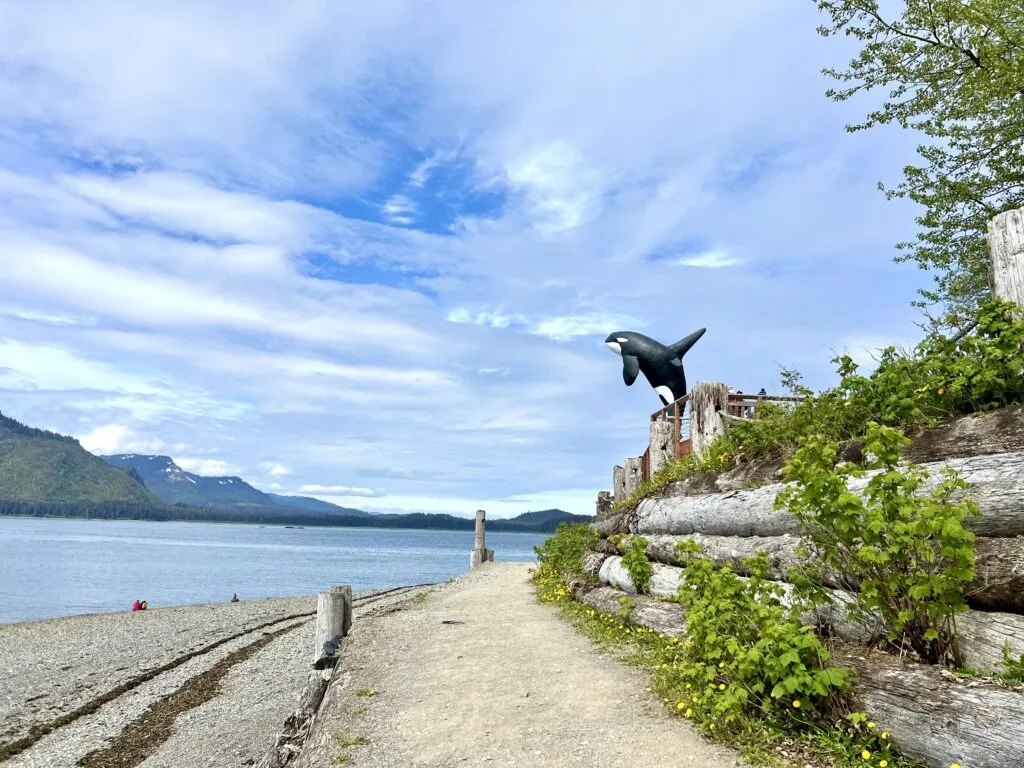
48. What type of jacket is best for an Alaska cruise?
The ideal jacket for an Alaska cruise is a waterproof, breathable shell with hood that allows for layering underneath. Look for jackets labeled “waterproof” (not just water-resistant). Further, a good Alaska cruise jacket should be windproof, lightweight enough to pack easily, and roomy enough to accommodate multiple layers beneath for adjustable warmth.
Rather than relying on an insulated jacket alone, the combination of waterproof shell plus packable midlayers and thermal bases allows adaptation to Alaska’s rapidly changing conditions. You can add or remove layers as temperatures fluctuate between chilly glacier viewings and warmer afternoons in port.
49. Do I need insect repellent for an Alaska cruise?
Bringing a travel-size insect repellent is advisable, particularly for forested shore excursions. Mosquitoes become more prevalent at inland locations, especially near freshwater sources and during the June/July warmer temperatures.
Ports along the Inside Passage experience considerably fewer insects than Alaska’s interior, but hiking trails around Juneau’s Mendenhall Glacier, Ketchikan’s rainforest paths, and Skagway’s woodland excursions can harbor enough mosquitoes to become bothersome. If your cruise includes a land extension to Denali, insect protection becomes significantly more important.
50. Should I bring binoculars for an Alaska cruise?
Binoculars are arguably one of the most important non-clothing items to pack for an Alaska cruise. The vast scale of Alaska’s landscapes means wildlife and scenic details often appear at distances beyond what the naked eye can fully appreciate. Though, quality compact binoculars are sufficient.
During glacier viewing, binoculars allow you to examine intricate ice formations and spot harbor seals resting on floating ice chunks. They’re equally valuable in ports for spotting bears along the shoreline or eagles perched in tall trees.
Of note, some cruise lines do provide in-cabin binoculars for guest use during the sailing, so check before purchasing and packing your own.
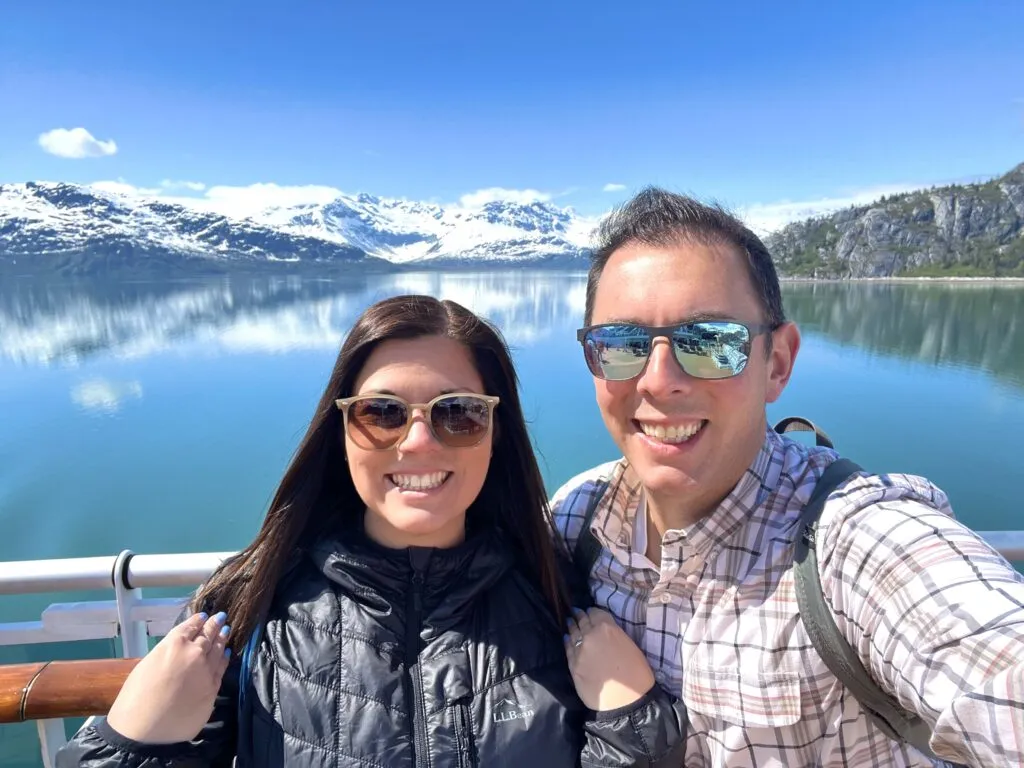
51. Will I need sunscreen on an Alaska cruise?
Sunscreen is surprisingly essential for Alaska cruises despite the cooler temperatures. Several factors create unexpectedly high UV exposure: reflective ice and snow surfaces, extended daylight hours, and thinner atmosphere at higher elevations.
Many travelers experience unexpected sunburns during glacier viewing or whale watching. Thus, cruisers should pack sunscreen and apply it daily, particularly when spending extended periods on open decks or during shore excursions.
52. Can I wear shorts on an Alaska cruise?
Daytime temperatures in ports typically range from the mid-50s to mid-60s°F, reaching the 70s on warm days in July and August. While we would recommend packing at least one pair of shorts, most passengers find lightweight pants more practical and comfortable for shore excursions.
That said, shorts can be very useful for around the ship. Think relaxing in your cabin or in the solarium, working out at the gym, or maybe even taking a dip in the pool.

Alaska Cruise Wildlife Questions
53. What wildlife will I see on an Alaska cruise?
Wildlife sightings on Alaska cruises vary but commonly include humpback whales, orcas, Dall’s porpoises, harbor seals, sea lions, sea otters, and abundant bald eagles. From the ship, you might spot black bears along shorelines during salmon runs (July-September). Though, bear viewing is more reliable through dedicated shore excursions. Mountain goats often appear on steep coastal cliffs, while moose and caribou require inland excursions.
Binoculars significantly enhance wildlife spotting—the ship’s naturalist or captain will make announcements for notable sightings. Small ship cruises focusing on wilderness areas rather than major ports offer increased wildlife opportunities through kayak excursions and zodiac tours.
54. What’s the best way to see bears in Alaska?
The most reliable bear viewing opportunities come with shore excursions rather than chance sightings from the ship. Top bear-watching excursions include flightseeing trips to Katmai National Park or Pack Creek on Admiralty Island (from Juneau), guided tours to Anan Wildlife Observatory (from Wrangell), and Neets Bay trips (from Ketchikan). For the greatest potential, book these tours during peak salmon runs (July-September) when bears congregate at streams.
Alternatively, consider adding a pre/post-cruise visit to Denali National Park, where bus tours through the park interior regularly encounter grizzlies.
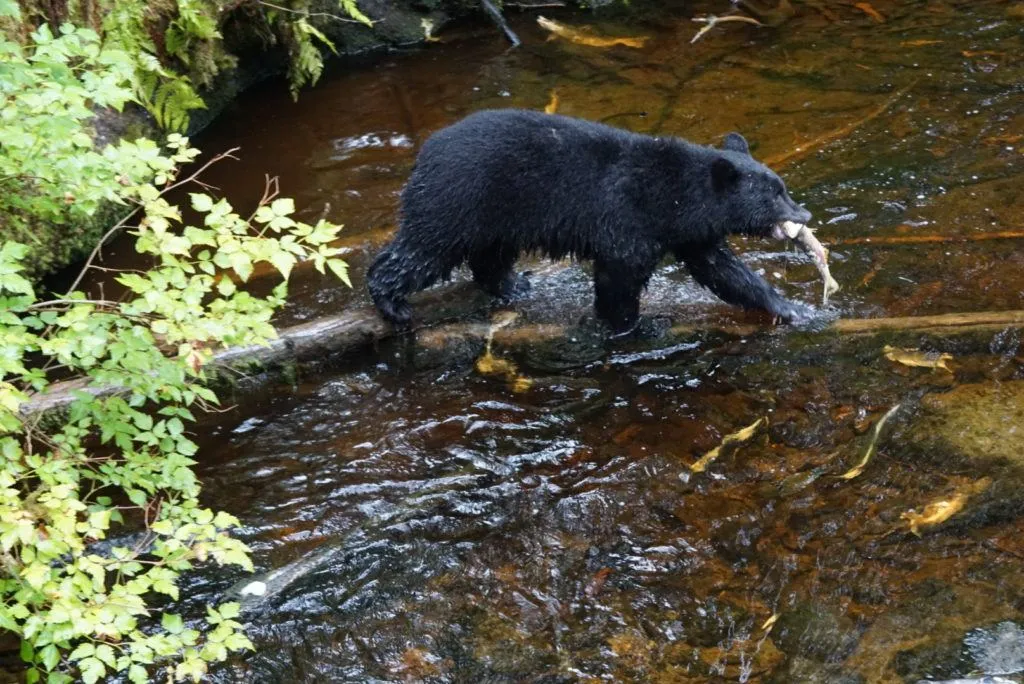
55. When is the best time to see whales in Alaska?
Humpback whale sightings peak from mid-June through early August, when these magnificent mammals feed in the nutrient-rich waters after migrating from Hawaiian breeding grounds. In Southeast Alaska, these feeding areas include Frederick Sound, Icy Strait, and Stephens Passage.
Orcas (killer whales) appear less predictably throughout the season, with May and September offering slightly better odds for these impressive predators. Gray whales typically migrate through Southeast Alaska waters in April and May, making early season cruises best for this species. While whale sightings are never guaranteed, most passengers on summer Alaska cruises encounter these magnificent marine mammals, even if at a distance.
56. How common are bald eagle sightings in Alaska?
Bald eagle sightings in Alaska are extremely common. Alaska hosts approximately 30,000 bald eagles, roughly half of America’s total population, with particularly high concentrations in Southeast Alaska’s cruise regions. The Inside Passage creates perfect eagle habitat with abundant salmon, protected waterways, and towering trees for nesting.
Passengers routinely spot eagles perched in shoreline trees or even alongside the roadway on utility poles. But there are also excursions to maximize your viewing potential. The Chilkat Bald Eagle Preserve near Haines (accessible via excursions from Skagway) hosts the world’s largest concentration. Alternatively, there’s also the Alaska Raptor Center in Sitka.
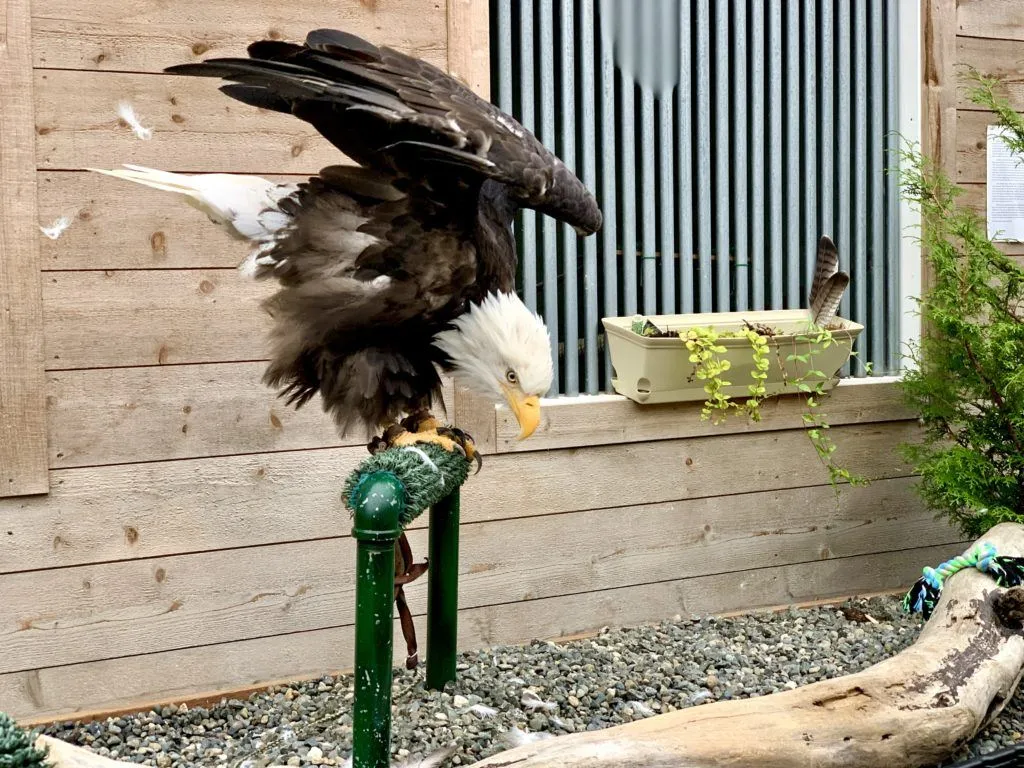
57. Will I see moose during my Alaska cruise?
Moose sightings are rare on standard Alaska cruises, as these animals typically inhabit inland areas away from cruise ports. The exception is cruises with land tour extensions to Denali National Park or Alaska’s interior. Occasionally, passengers spot moose during shore excursions to the Mendenhall Glacier near Juneau or on extended tours outside Ketchikan or Skagway, particularly near freshwater lakes and streams.
Alaska Cruise Glacier Related Questions
58. Will I see glaciers on my Alaska cruise?
Nearly every Alaska cruise itinerary includes at least one glacier viewing opportunity, though the specific glaciers and viewing experiences vary. Most Inside Passage cruises visit either Glacier Bay National Park (featuring Margerie and Lamplugh Glaciers), Tracy Arm Fjord (Sawyer Glaciers), Endicott Arm (Dawes Glacier), or Hubbard Glacier. Gulf of Alaska itineraries might additionally include College Fjord with its multiple tidewater glaciers. When researching cruises, verify which specific glaciers are included rather than assuming all itineraries offer equivalent experiences.
For closer glacier encounters, consider excursions like helicopter landings, guided glacier hikes, or glacier explorer boat tours.

59. What is Glacier Bay and why is it special?
Glacier Bay National Park and Preserve is the crown jewel of Alaska cruise destinations. It’s a UNESCO World Heritage Site encompassing more than 3 million acres of protected marine ecosystem, including spectacular tidewater glaciers.
Ships spend several hours cruising the bay, approaching massive glaciers like Margerie Glacier while National Park Rangers provide expert narration. However, not all cruise lines have permits to enter this highly regulated park, so check itineraries carefully—Princess, Holland America, and Norwegian hold the most entry permits, making their itineraries particularly desirable for first-time Alaska visitors.
60. How close do cruise ships get to glaciers?
Cruise ships typically approach active tidewater glaciers to within 1/4 to 1/2 mile. This is close enough to witness calving and appreciate the glacier’s scale, but maintaining a safe distance from potential hazards. Small expedition vessels can usually navigate closer to glacier faces, while traditional cruise ships compensate for their greater distance with height advantage.
For truly close glacier encounters, consider shore excursions like helicopter landings, guided ice hikes, or small boat tours which can provide more intimate experiences under appropriate safety protocols.
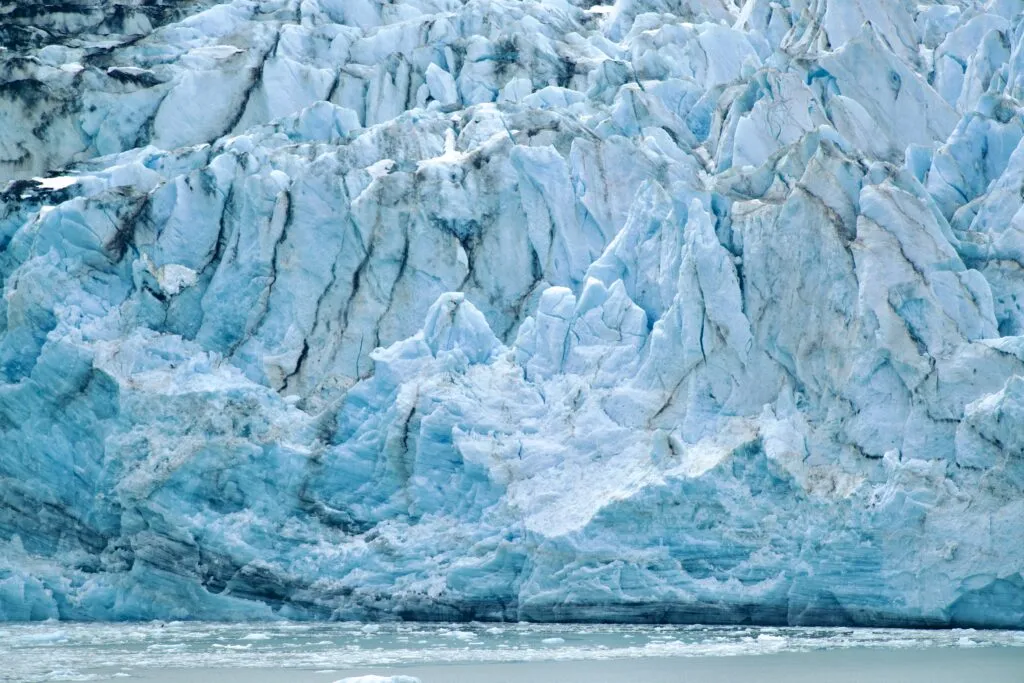
61. Is it better to visit Glacier Bay or Hubbard Glacier?
Both Glacier Bay National Park and Hubbard Glacier offer spectacular experiences, though with distinct characteristics that might influence your preference. Glacier Bay provides a comprehensive glacial experience with multiple glaciers over a good portion of the day, accompanied by National Park rangers providing expert commentary.
Hubbard Glacier, while a single destination, is North America’s largest tidewater glacier with a towering 400-foot ice face stretching six miles wide. Hubbard typically offers closer viewing distances and more reliable calving activity.
For first-time visitors, we give Glacier Bay the edge. But keep in mind that not all cruise lines have permits to enter this national park.
62. Can I see glaciers without booking an excursion?
Yes, every Alaska cruise includes at least one day of dedicated glacier viewing as part of the standard itinerary, with no additional excursion or fees required. Most cruises feature 4-8 hours of scenic cruising through either Glacier Bay National Park, Tracy Arm Fjord, Endicott Arm, College Fjord, or Hubbard Glacier. During these segments, the ship navigates close to massive tidewater glaciers.
The ship typically rotates 360° for viewing from all sides and pauses for an extended period near active glacier faces, offering ample opportunity to witness calving events. For more intimate glacier experiences, shore excursions are recommended.

Alaska Cruise Shore Excursions Questions
63. How much do shore excursions cost in Alaska?
Alaska shore excursion prices vary widely depending on activity type. Basic experiences like city walking tours, salmon bakes, or museum visits typically range from $40-$80 per person. Mid-range activities such as whale watching, guided hikes, or cultural performances usually cost $100-$200. Premium adventures including helicopter glacier landings or fishing charters range from $300-$600+. The most exclusive experiences, like private floatplane tours or full-day combination adventures, can exceed $700 per person.
You should pre-book these popular excursions well in advance as they frequently sell out.
64. What are the must-do excursions in Juneau?
Juneau, Alaska’s capital, offers exceptional excursions highlighted by Mendenhall Glacier, just 12 miles from downtown. The most popular experiences include helicopter tours landing directly on the glacier for guided walks across its ice; whale watching excursions in Auke Bay; and the Mount Roberts Tramway, ascending 1,800 feet for panoramic views and hiking trails.
Adventure seekers can enjoy dogsledding camps operating on glaciers (combining helicopter access with mushing experiences), while Juneau’s surrounding rainforest provides opportunities for zipline canopy tours and guided hiking. Cultural options include Alaska Native dance performances at Centennial Hall and gold panning at historic sites.

65. What are the best excursions in Skagway?
Skagway’s premier excursion is the White Pass & Yukon Route Railway, a historic narrow-gauge railroad climbing nearly 3,000 feet following the original Klondike Gold Rush trail. This National Historic Landmark offers multiple options: a standard summit excursion; extended journeys to Fraser, British Columbia (passport required); and combination adventures pairing the train with bicycling, hiking, or rafting.
Beyond the railway, popular experiences include Jeep or Hummer tours along the Klondike Highway to the Yukon; gold panning expeditions; and rafting trips on the Taiya River. Downtown Skagway’s preserved Gold Rush architecture is great for self-exploration. It houses the Klondike Gold Rush National Historical Park and other landmarks from the area’s colorful past (like the Red Onion Saloon).
66. What can I do in Ketchikan?
Ketchikan, Alaska’s “First City” and self-proclaimed Salmon Capital of the World, offers diverse excursions highlighting Native culture, wildlife, and outdoor adventures. Must-see attractions include Creek Street, a historic boardwalk built over the water with former brothels converted to unique shops; Totem Heritage Center and Saxman Native Village, housing collections of totem poles; and Misty Fjords National Monument, accessible via flightseeing or catamaran tours.
Wildlife experiences include black bear viewing at Neets Bay salmon hatchery, and adventure seekers can enjoy zipline courses through the rainforest canopy, fishing charters, and “duck” tours combining city sites with harbor views. Families will also love the Great Alaskan Lumberjack Show, offering entertaining competitions in traditional timber skills.
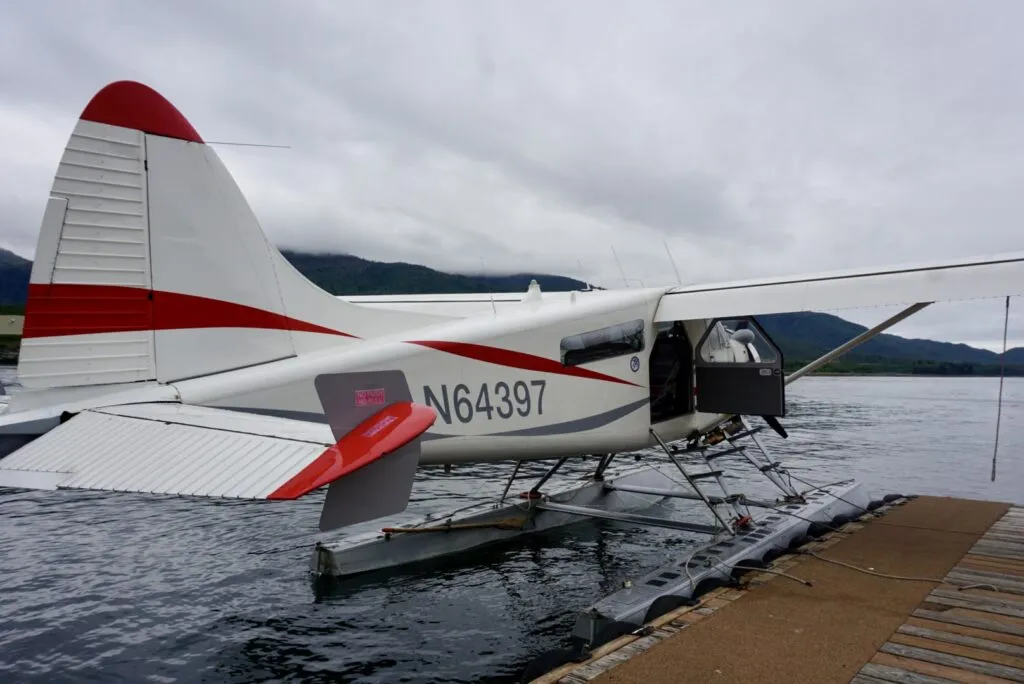
67. What are the best things to do in Sitka?
Sitka offers Alaska’s most distinctive cultural blend, combining Tlingit Native heritage with Russian colonial history. Top experiences include exploring Saint Michael’s Cathedral and the Russian Bishop’s House from 1842; viewing the extensive collection of restored totem poles at Sitka National Historical Park; and visiting the Alaska Raptor Center, where injured bald eagles and other birds receive rehabilitation.
Wildlife enthusiasts can enjoy tours to observe sea otters, whales, and seabird colonies on nearby islands, and Fort Abercrombie State Historical Park provides scenic hiking through a World War II coastal defense site. Sitka’s compact downtown is easily walkable, though it often requires shuttle service to reach from the ship.
68. What is Icy Strait Point?
Icy Strait Point offers an authentic, Native-owned destination unlike typical Alaska ports. Located near the Tlingit village of Hoonah, this privately developed cruise port features a restored 1912 salmon cannery housing historical exhibits, local shops, and restaurants serving fresh seafood. Its signature attraction is the world’s longest ZipRider, descending 1,300 feet from mountaintop to seaside at speeds reaching 60 mph.
Other excursions include whale watching, bear viewing at nearby streams, and ATV adventures through forests. Cultural experiences feature tribal house visits with Native storytelling and traditional dance performances.
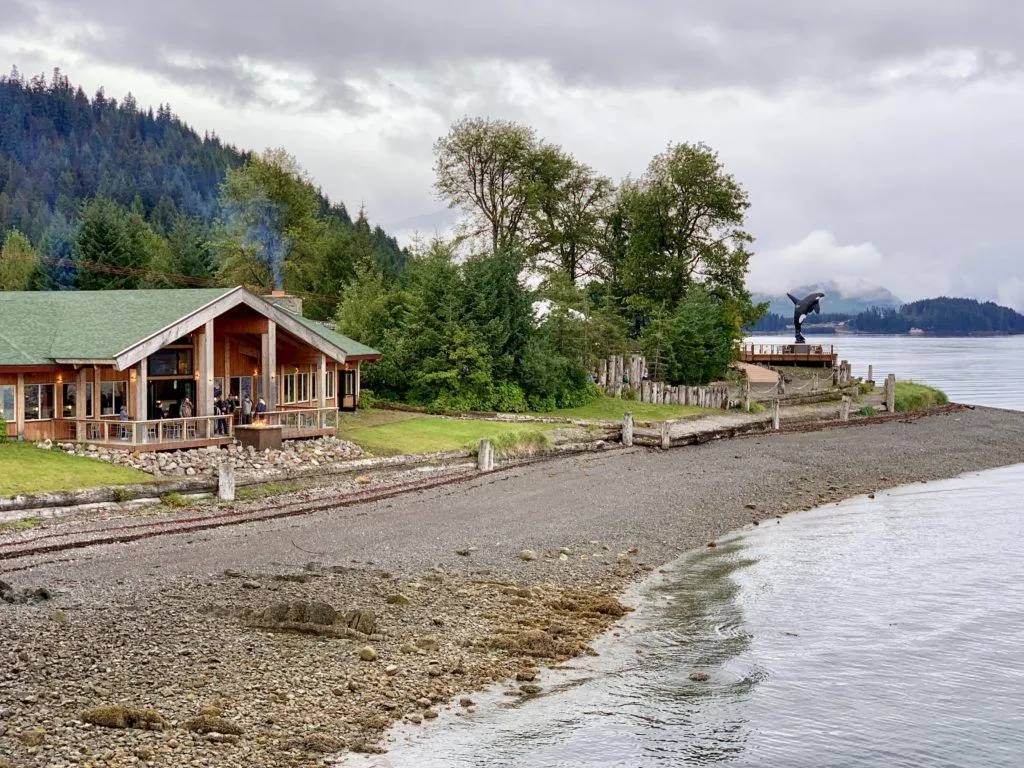
69. What Alaskan foods should I try in port?
Alaskan ports offer exceptional seafood and unique local specialties worth seeking out while ashore. Must-try items include king crab legs, fresh-caught wild salmon, halibut prepared as fish and chips, prawns, reindeer sausage, wild berry desserts, and beer from craft breweries.
Popular port restaurants include Tracy’s King Crab Shack in Juneau, Skagway Brewing Company, and New York Cafe in Ketchikan. For sampling multiple Alaskan specialties, consider food-focused walking tours or salmon bakes offering traditional outdoor dining experiences with cultural performances.
FYI- markets typically provide vacuum-sealed seafood products that can be packed in checked luggage or shipped back home.

70. What should I do in Seattle before or after my cruise?
Seattle offers several pre/post-cruise experiences warranting at least one or two additional days. Must-see attractions easily accessible from cruise terminals include Pike Place Market (the iconic public market featuring flying fish, artisan foods, and the original Starbucks); the Space Needle and adjacent Museum of Pop Culture (MoPOP) in Seattle Center; and the scenic waterfront with its Seattle Great Wheel and Seattle Aquarium.
Unique experiences include Chihuly Garden and Glass showcasing spectacular blown glass installations, Underground Seattle tours exploring the city’s buried original streets, and the Museum of Flight for aviation enthusiasts.
71. What should I do in Vancouver before or after my cruise?
Vancouver consistently ranks among North America’s most beautiful cities and also warrants a couple days of exploration before or after your Alaska cruise. Canada Place cruise terminal’s downtown location provides walking access to many attractions.
Must-see experiences include Stanley Park’s magnificent seawall path, Granville Island Public Market with artisan foods and crafts, Capilano Suspension Bridge Park, and Gastown’s historic district with Victorian architecture and the famous steam clock. Active visitors will also enjoy Grouse Mountain’s aerial tramway providing panoramic views and seasonal activities.
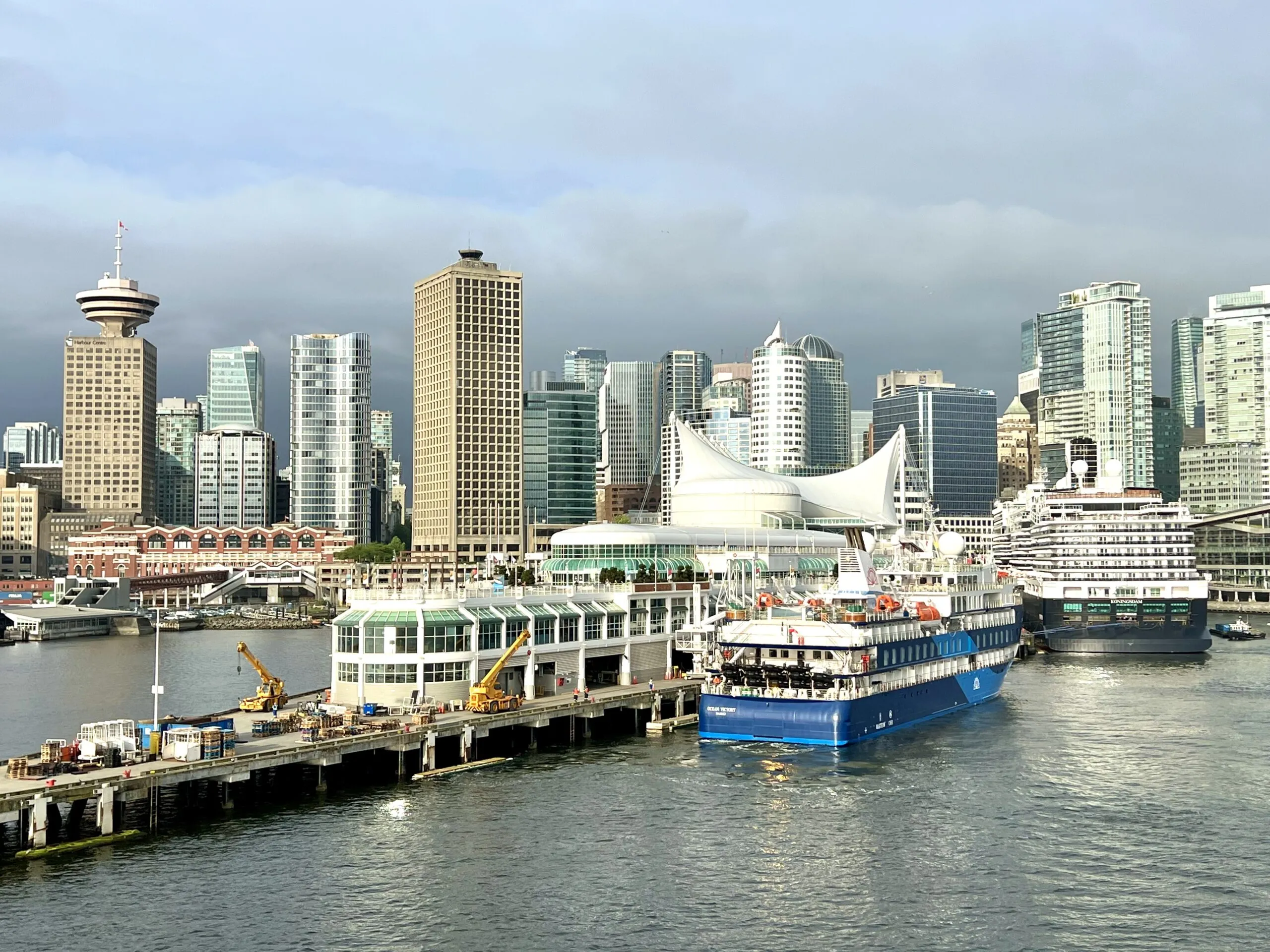
72. What’s the best port for fishing excursions?
Ketchikan earns its title as “Salmon Capital of the World,” offering Alaska’s premier cruise port fishing opportunities. The city provides convenient access to protected waters teeming with all five Pacific salmon species, halibut, and more. Numerous companies here operate half-day and full-day charters utilizing comfortable vessels equipped specifically for Alaska fishing conditions.
When booking, verify if your excursion provides processing services, as many can vacuum-seal and flash-freeze your catch for shipping home.
73. Should I book excursions through the cruise line or independently?
Both cruise line and independent excursion bookings offer distinct advantages worth considering. Cruise line excursions provide guaranteed return-to-ship service (the ship waits if excursions run late), seamless cancellation policies, and vetted operators with proper insurance and safety standards. However, these benefits come at a premium price, typically 20-30% higher than identical tours booked independently.
Independent bookings through local operators or platforms like Viator and Shore Excursions Group generally offer lower prices, smaller group sizes, more customization options, and sometimes unique experiences. Shore Excursions Group even offers a return-to-ship guarantee.
74. Are helicopter glacier landings worth the cost?
Helicopter glacier landings are one of Alaska’s highly sought after shore excursions. Prices typically run between $375-$599 per person, but deliver a one-in-a-lifetime experience. These excursions can combine spectacular flightseeing over otherwise inaccessible wilderness with the opportunity to actually walk on a glacier’s surface.
Primary helicopter glacier landing ports include Juneau (Mendenhall Glacier), Skagway (Meade Glacier), and Talkeetna (for Denali flightseeing with glacier landings on extended cruisetours). Though expensive, satisfaction ratings for these excursions support their reputation as Alaska’s ultimate splurge-worthy adventure. And we agree! It only took us three attempts, but we finally did it and would book again in a heartbeat.
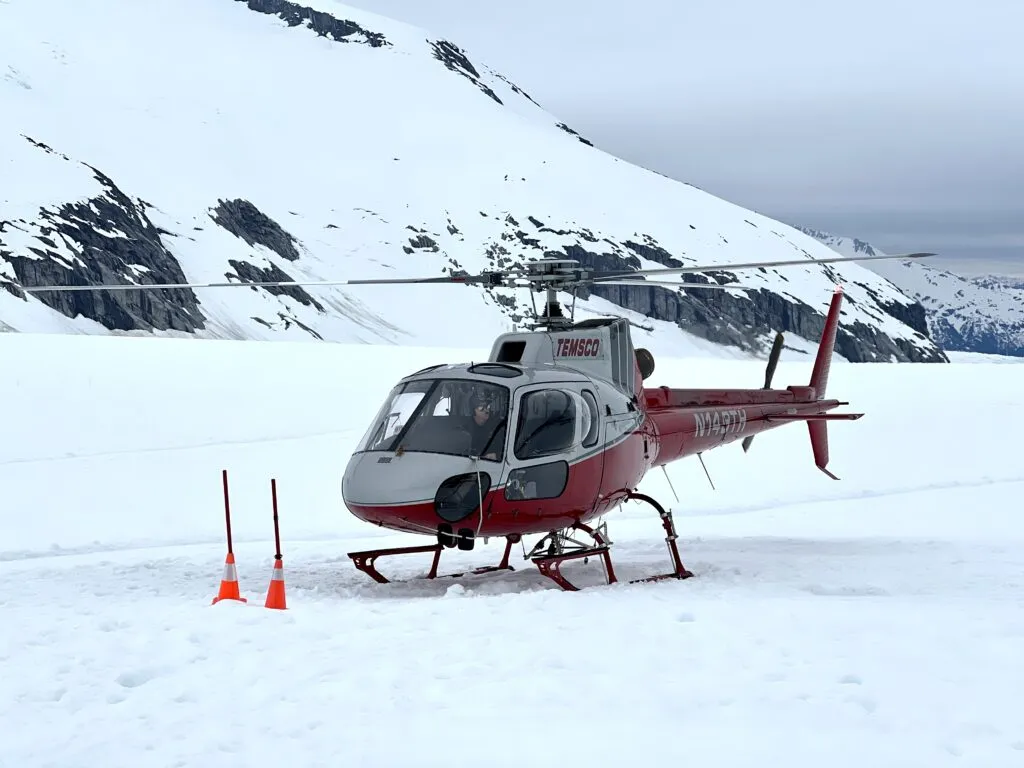
75. What are some unique Alaska experiences not to be missed?
Beyond standard port visits, Alaska offers several unique experiences. Witnessing bubble-net feeding humpback whales is a wildlife spectacle seen few places worldwide— something we have not been lucky enough to see yet even with six Alaska cruises under our belt. The White Pass & Yukon Route Railway from Skagway climbs through breathtaking mountain terrain along the historic Gold Rush trail.
For cultural immersion, attend an authentic Native Tlingit performance at Saxman Native Village (Ketchikan) or Icy Strait Point. Flightseeing over Misty Fjords National Monument reveals a landscape of granite cliffs, waterfalls, and valleys inaccessible by road. And as mentioned above, walking on a glacier is another not-to-be-missed experience.
Comments
Do you have any other Alaska cruise questions that we didn’t answer? What’s your advice to first-time Alaska cruisers? Drop us an anchor below to share your experiences cruising way up north.


